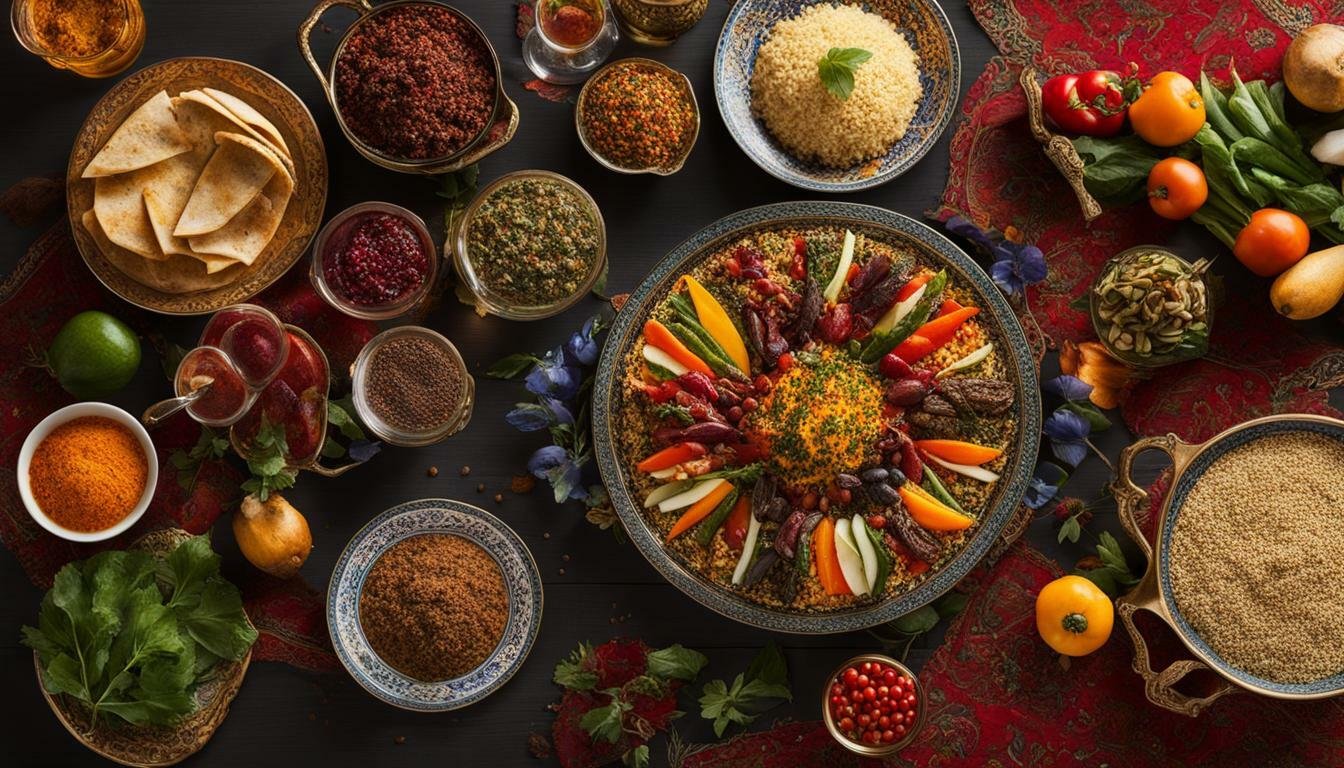Take Me to The Recipes
Prepare yourself for a feast for the senses! Join us on an exploration of Iranian cuisine, where history, vibrant spices, and warm hospitality intertwine to create a truly unforgettable experience. This journey unveils 22 authentic recipes, each one a delicious gateway to Iran’s rich cultural tapestry.
Delve into the fascinating past, uncovering how ancient empires, diverse traditions, and religious influences have shaped every dish. You’ll see how the country’s unique geography and climate, from mountain ranges to fertile plains, have nurtured a bounty of ingredients, forming the cornerstone of Iranian cooking.
But our exploration goes beyond mere flavors. We delve into the heart of the Iranian people, renowned for their remarkable hospitality and resilience. Despite facing various challenges, their spirit of generosity and warmth shines through, making every culinary encounter a testament to their enduring strength.
Get ready to tantalize your taste buds with fragrant stews, fluffy rice dishes, succulent kebabs, and sweet delights infused with rosewater and pistachios. With each bite, you’ll not only savor the unique flavors of Iran but also gain a deeper understanding of its people and their captivating story.
So, put on your apron, gather your loved ones, and embark on this culinary adventure! Let the aromatic spices transport you, the historical anecdotes enrich your understanding, and the genuine warmth of Iranian hospitality fill your heart. Bon appétit!
Iranian Cuisine Key Takeaways
- Most people know Iranian Cuisine and recipes for their rich flavors, vibrant spices, and unique cooking techniques.
- Persian cuisine has a long and rich history that is steeped in tradition and culture.
- Exploring Iranian food culture will offer an unforgettable culinary experience.
- Generations pass the traditional Iranian dishes to the next one making it an integral component of the Iranian culture.
- Iranian ingredients, such as saffron, dried limes, and rosewater, add depth and complexity to Persian dishes.
Take Me to The Recipes
Where is Iran?

Iran is located in West Asia and borders the Caspian Sea, Persian Gulf, and Gulf of Oman. Topographically, it is predominantly located on the Persian Plateau.

Index to the Contents
- Take Me to The Recipes
- More Articles
- Interesting Facts About Iran
- Iran’s History and the Affect It Has Had on the Cuisine
- What impact has the climate and geography had on Iranian Food?
- Exploring Iranian Food Culture
- How healthy is Iranian Food?
- Traditional Iranian Cuisine: A Taste of Persia
- Savor the Flavors of Iran – Culinary Journey
- Iranian Cooking Techniques
- Iran National Dish
- Popular Iranian Recipes
- Bringing Iranian Cuisine to Your Kitchen
- Conclusion
- FAQ’s
You may also be interested in the following articles
- North and South American Cuisine – A Culinary Expedition
- Europe Cuisine: Savor the Continent’s Best Culinary Secrets!
- African Cuisine: Discover the Bold Flavors & Global Charm!
- Asian Cuisine Unlock its Secrets – Taste, Health & Global Influence!
Savor iconic Iranian Recipes – Click on each tantalizing Image to open up the Recipe
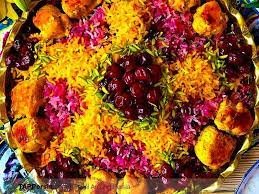
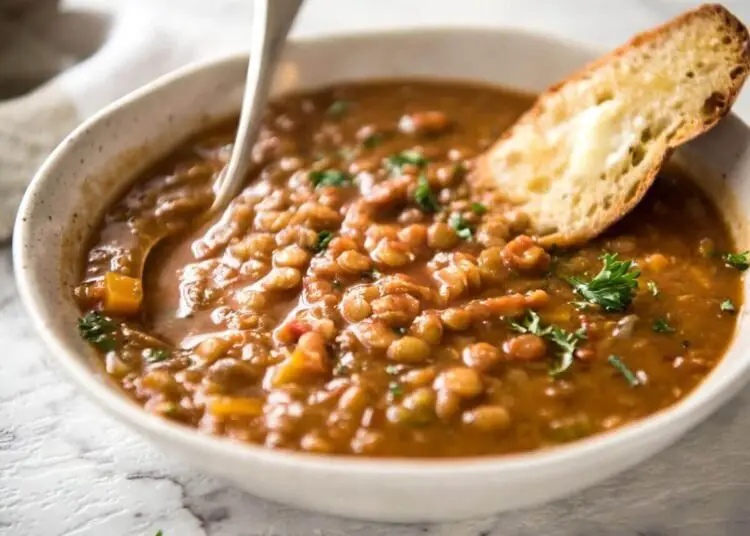
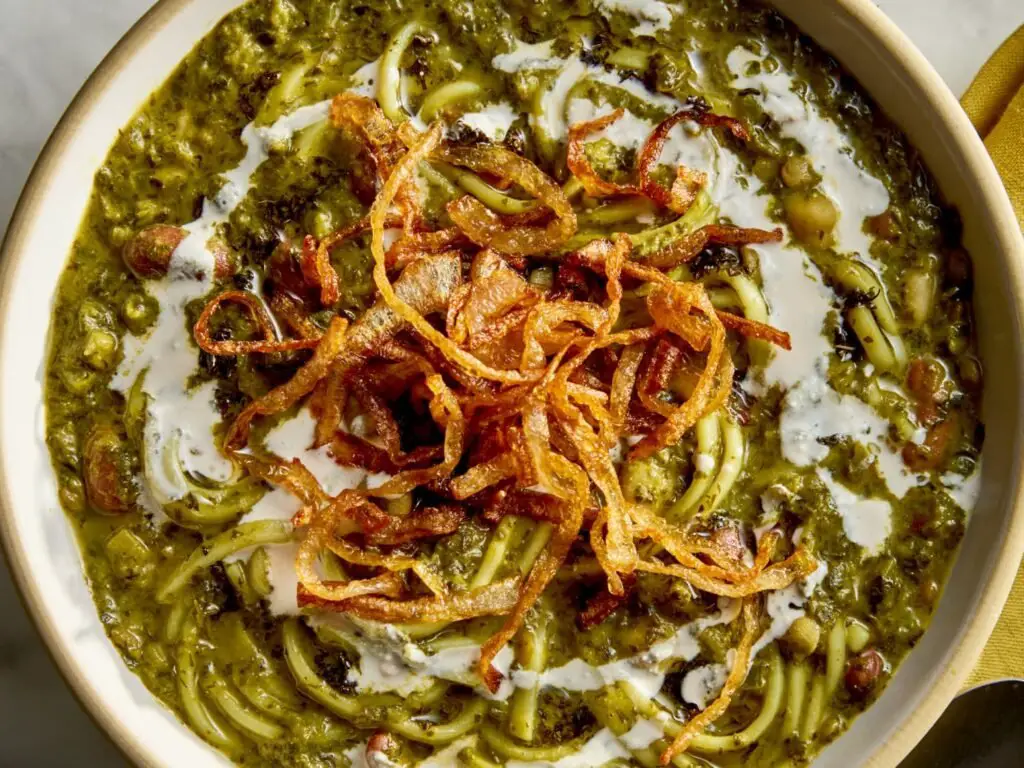
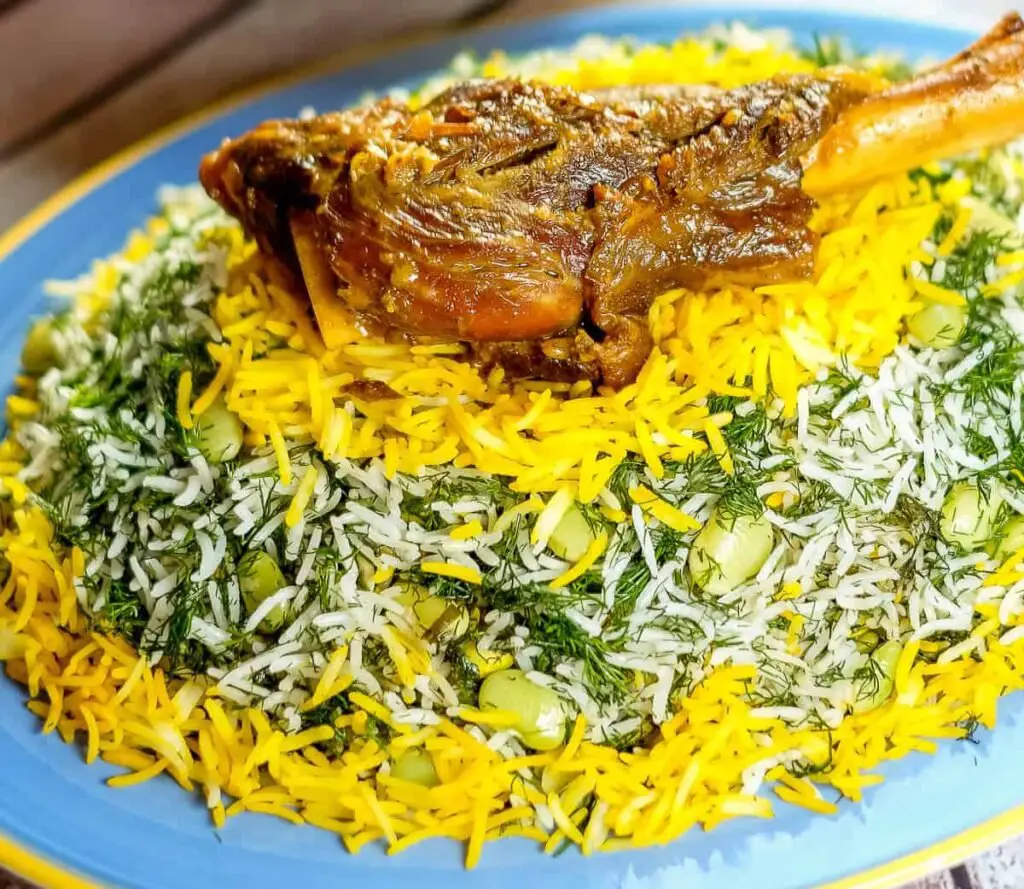
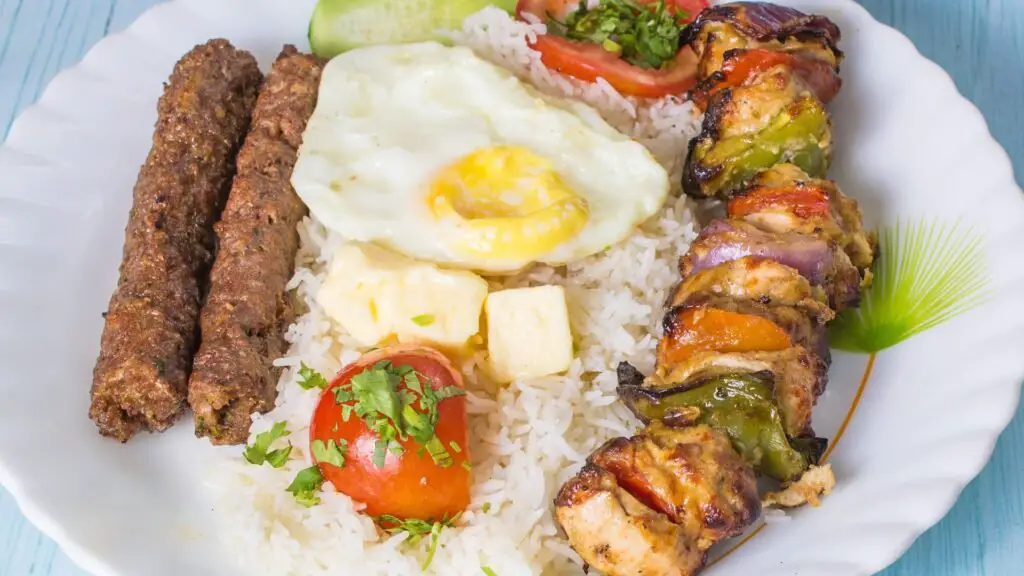
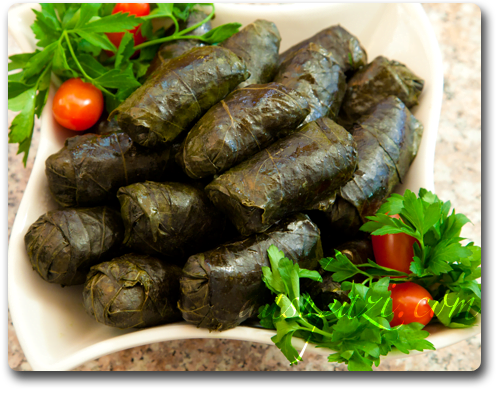
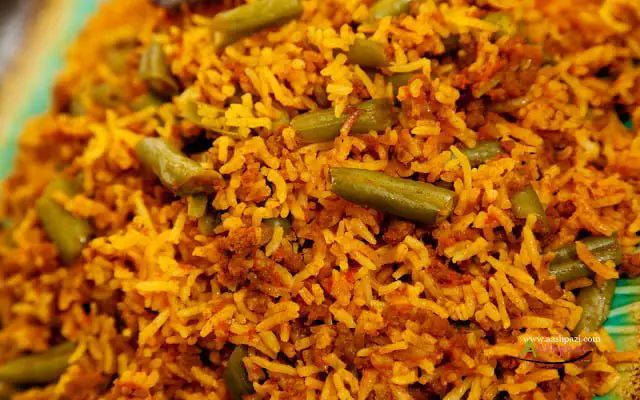
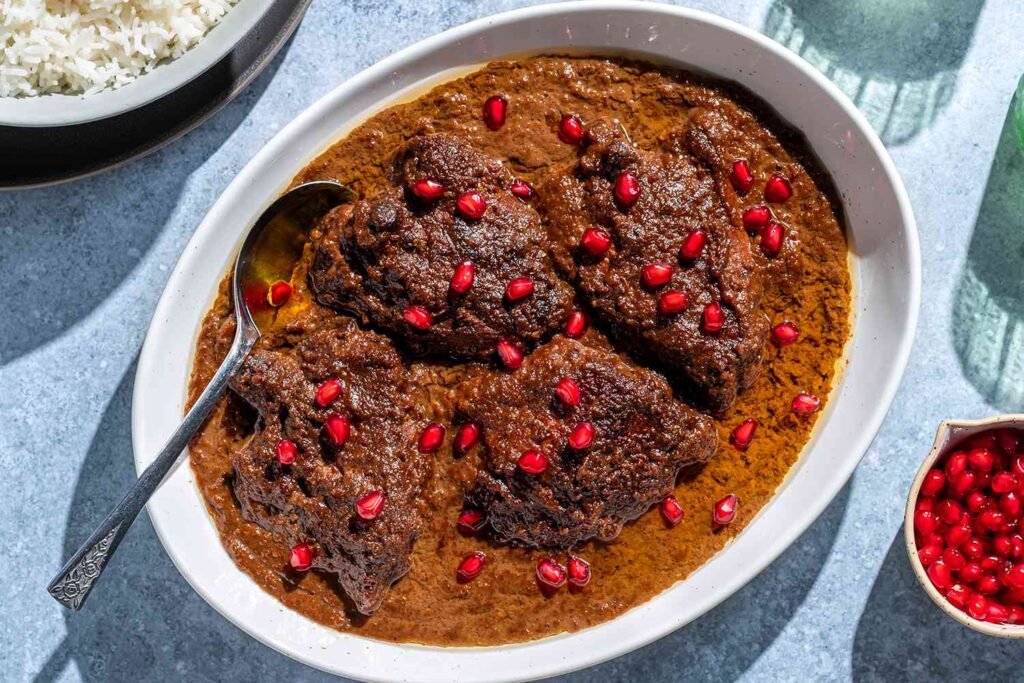

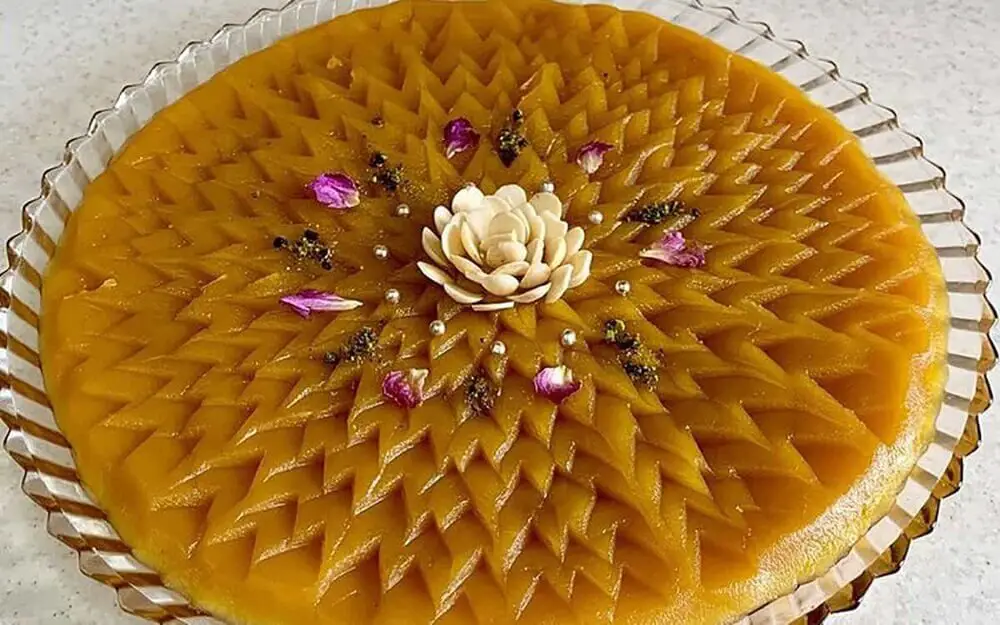
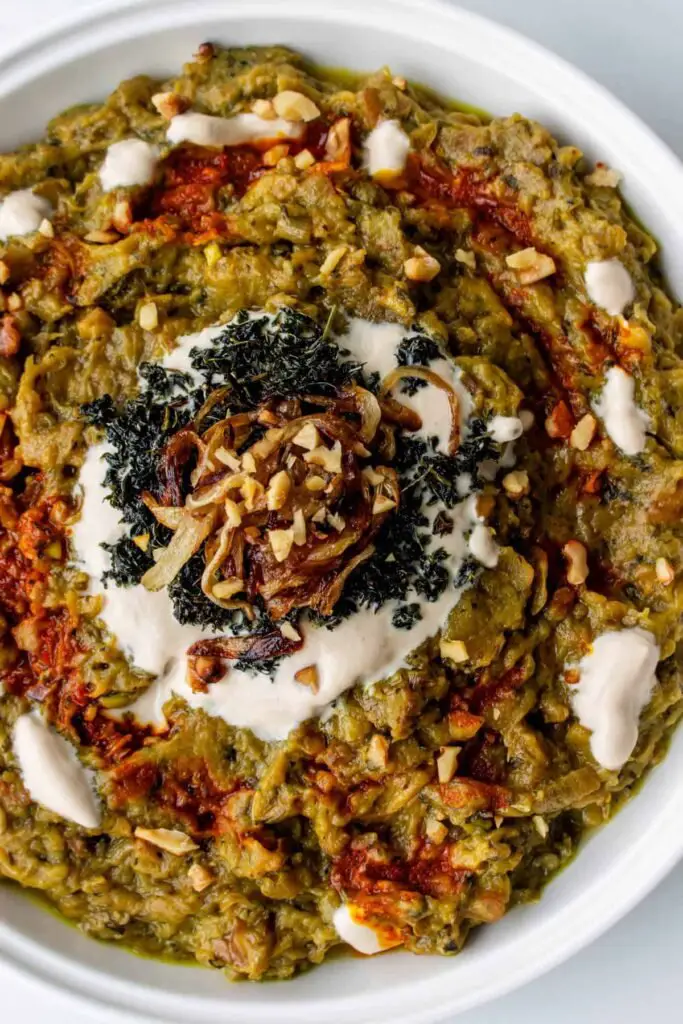
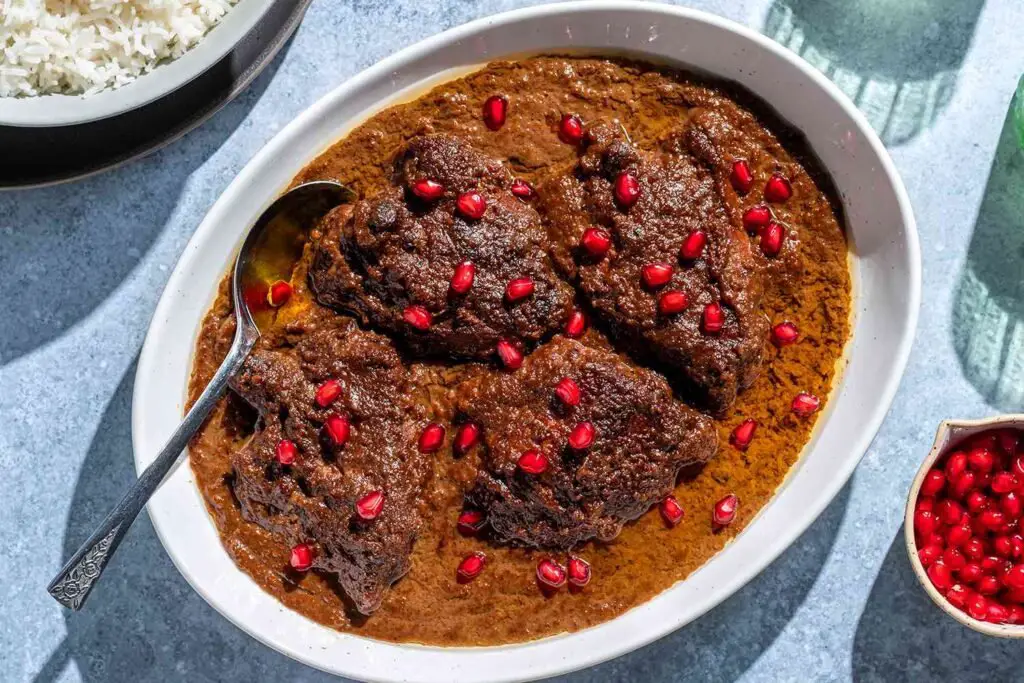

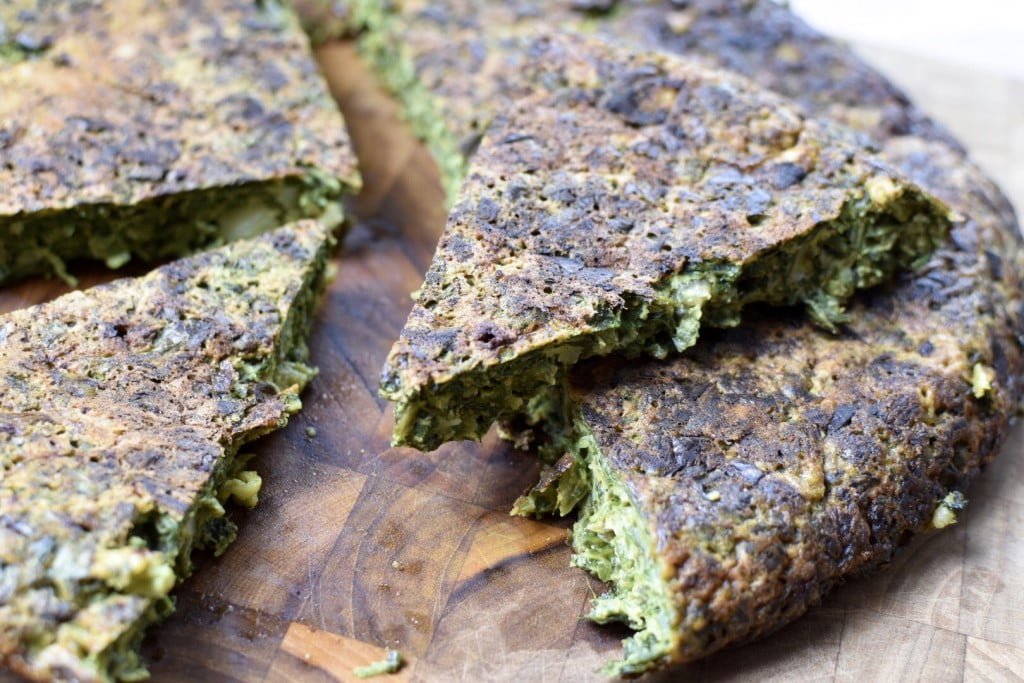
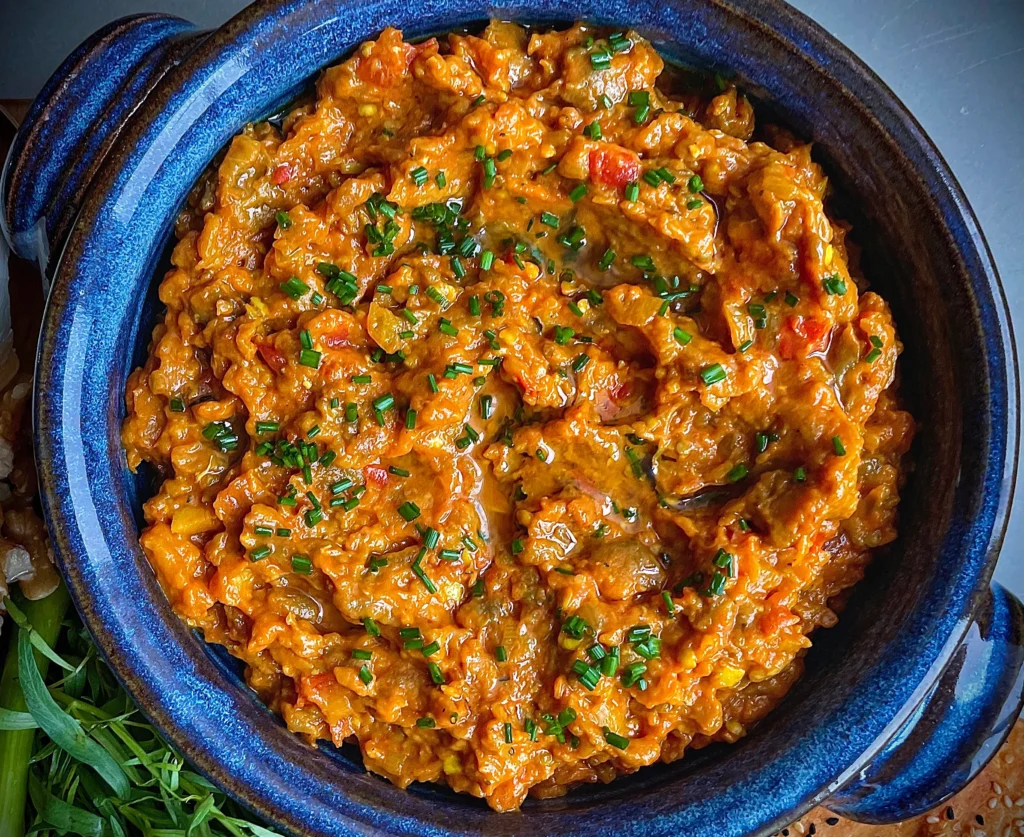
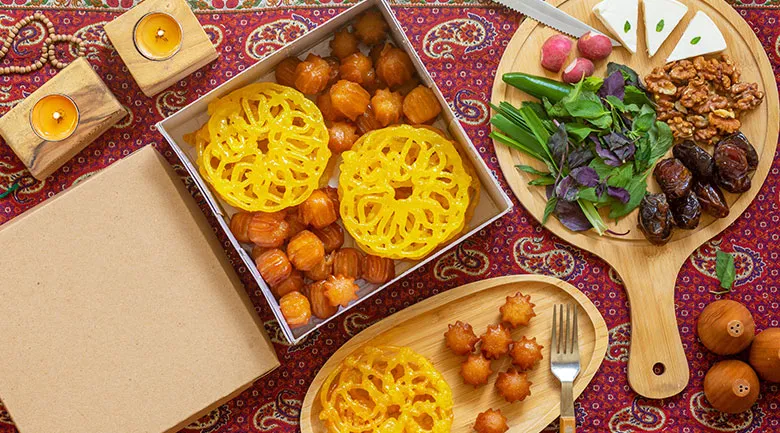
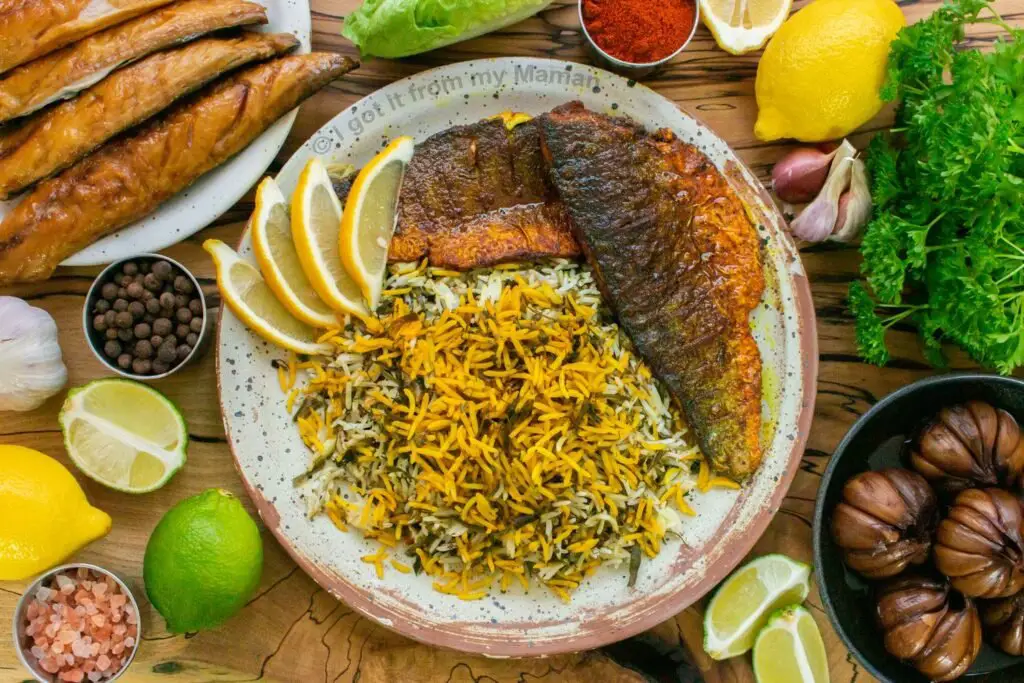

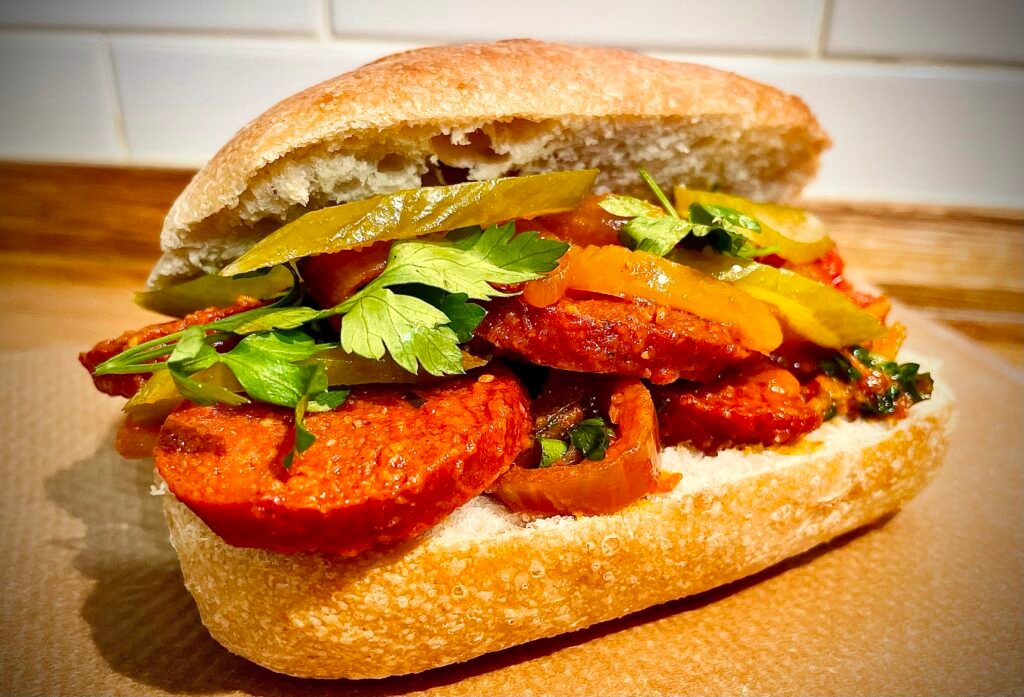

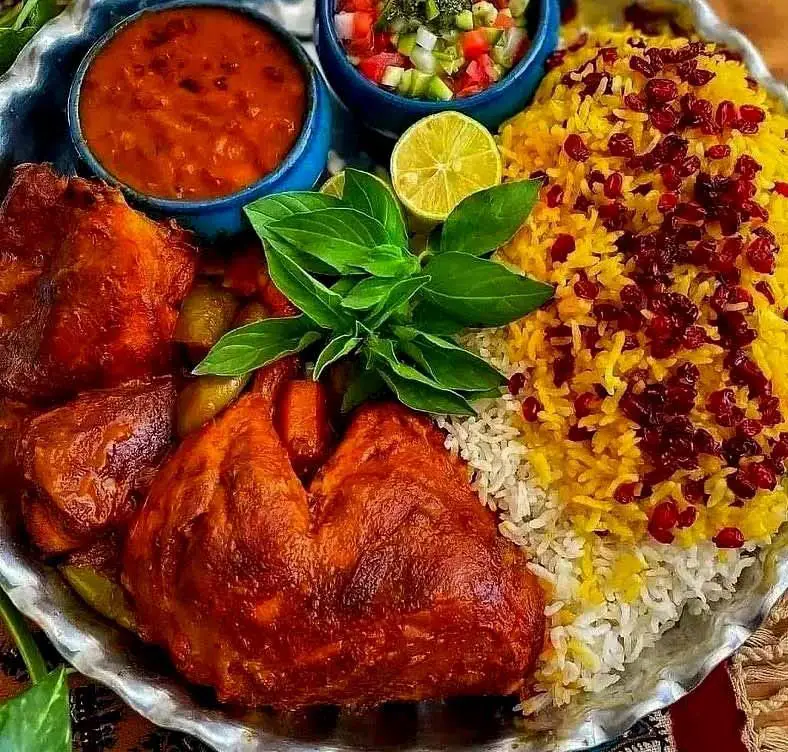
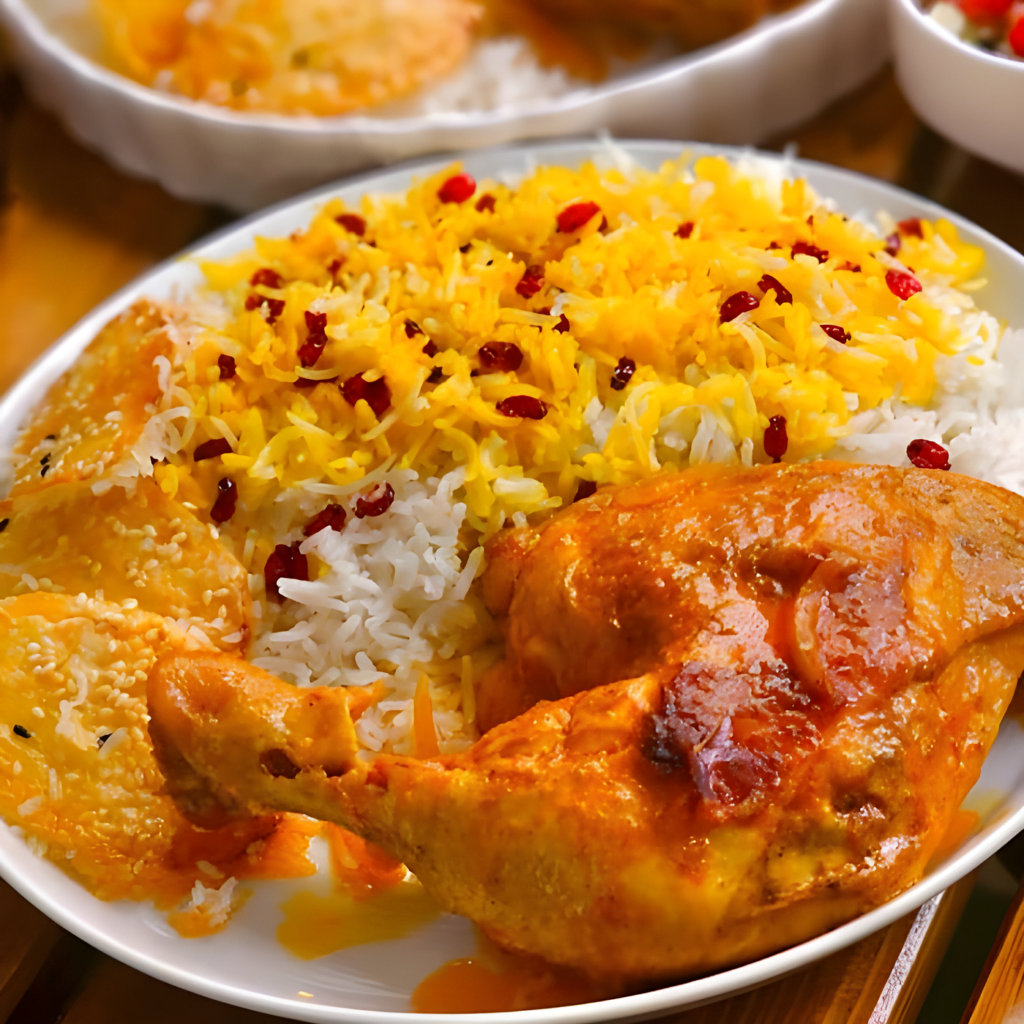
Interesting Facts About Iran
Ancient Civilization

Iran, formerly known as Persia, boasts one of the world’s oldest civilizations, with a history dating back thousands of years.
Persia was the dominant nation of western Asia for over twelve centuries.
It was a major center of the ancient Persian Empire.
Nose Jobs Capital

Iran has one of the highest rates of rhinoplasty (nose jobs) per capita in the world. Plastic surgery, particularly nose reshaping, is remarkably popular among Iranian men and women.
World’s Largest Covered Bazaar

Tehran’s Grand Bazaar is one of the largest covered markets globally, covering over 10 kilometers of labyrinthine alleys. It’s a bustling hub for commerce, attracting locals and tourists alike.
No Valentine’s Day Celebrations

While many countries celebrate Valentine’s Day, in Iran, it was banned for several years due to its perceived Western origins. Despite the ban being lifted, the celebrations are still relatively low-key.
Cat Lovers’ Paradise

Iranians have a deep affection for cats. There are numerous famous stories and poems in Persian literature that celebrate the beauty and charm of cats. You’ll find many stray cats cared for by locals.
Underground Homes



In the ancient city of Kashan, some traditional houses are constructed underground to escape the extreme temperatures of the region. These subterranean dwellings showcase innovative architectural techniques.
Gigantic Sand Dunes

Iran is home to the Varzaneh Desert, known for its mesmerizing sand dunes. Some of these dunes reach heights of over 500 feet, providing a surreal landscape for travelers and photographers.
The World’s Largest Wind Towers

Yazd, an ancient city in Iran, is famous for its Badgirs, or wind towers. These traditional structures capture and direct the wind to cool buildings, and some of them are among the world’s tallest.
Poetry Lovers
Iranians have a deep appreciation for poetry. The works of renowned poets like Rumi and Hafez hold a special place in Iranian culture. Poetry is often recited at social gatherings.
Traffic-Conscious Penguins

In an effort to promote traffic safety, the Iranian police employed a team of penguins to direct and control traffic in the city of Bandar Abbas. The quirky initiative aimed to raise awareness about road safety.
Take Me to The Recipes
A Culinary Journey Through Persian History: From Bustling Feasts to Modern Challenges
Iran boasts a rich and complex history spanning millennia, reflected in its diverse and flavorful cuisine. Each period left its mark on the Iranian culinary landscape, shaping ingredients, flavors, and cooking techniques we experience today. However, recent challenges, including international sanctions, have added a complex layer to this culinary story.
Pre-Achaemenid Era (Before 550 BC)
Iranians lived as pastoralists and farmers, cultivating crops like barley, wheat, and vegetables, and raising livestock such as sheep, goats, and cattle.
These early agricultural practices laid the groundwork for developing culinary traditions later in history.
Achaemenid Empire (550–330 BC)

Flourishing trade networks facilitated the exchange of new foods and culinary techniques.
Spices from India and bread-making techniques from Mesopotamia influenced Iranian cuisine.
Parthian and Sassanian Empires (247 BC– 224 AD)

Fruits, nuts, and herbs became prominent.
Slow cooking techniques were established to enhance flavors and textures.
Arab Influence (Post-Sassanian Era)

After the Sassanid Kingdom’s collapse, Arabs became familiar with Iranian lifestyle and cuisine.
Iranian presence in the Abbasid Caliph’s palace further increased this familiarity. Persian cuisine influenced dynasties like Seljuks, Ilkhanids, and Mughals
In summary, Iranian cuisine reflects a rich tapestry of history, cultural exchanges, and resilience. Despite challenges, Iranians continue to celebrate their culinary heritage, adapting to changing circumstances while preserving the essence of their traditional dishes. 🍽️
Pre-Islamic Era (224 – 651 AD)
This period laid the foundation for Iranian cuisine, featuring staples like wheat, barley, dates, nuts, and dairy. Souring techniques for preservation gave rise to dishes like kashk (dried yogurt). Influences from neighboring civilizations like Mesopotamia and India introduced spices like turmeric and cumin.
Islamic Era (651 AD – Present)

The arrival of Islam brought halal dietary restrictions, favoring meat from permitted animals and influencing cooking methods. Rice gained prominence, replacing some wheat consumption.
Spices like saffron, cardamom, and cinnamon became more prevalent, adding complexity to dishes. Sweet dishes featuring rosewater and pistachios emerged, reflecting Persian love for delicate flavors.
Major Dynasties
Iran was ruled by four main dynasties between 661 and 1926 AD.
Umayyad Caliphate (661-750 AD)

Introduction of cooking pots and stewing techniques leading to dishes like khoresh (stew).
Abbasid Caliphate (750-1258 AD)
Flourishing of trade and agriculture, leading to diverse ingredients and elaborate courtly cuisine. Sugar became more available, influencing sweet dishes.
Safavid Dynasty (1501-1736 AD)
Emphasis on shi’a Islam, leading to the prominence of vegetarian dishes during religious festivals. Rice dishes like chelo (plain rice) and tahdig (crispy rice crust) perfected.
Qajar Dynasty (1789-1925 AD)
Increased European influence, introducing new ingredients like potatoes and tomatoes. French culinary techniques adapted to create Persian fusion dishes.
Modern Iran Pre-Revolution (1925-1979)

Modernization and globalization continue to shape Iranian cuisine. Street food culture thrives, offering falafel, kebabs, and shawarma. Fast food chains have gained popularity, but traditional dishes remain central to family meals and celebrations. Fusion cuisine combines international influences with local ingredients, creating exciting new flavors.
Iranian Revolution (1979 Present)

The 1979 Iranian Revolution brought about significant changes in various aspects of Iranian society, including its cuisine. While Iranian cuisine has deep-rooted traditions, the revolution had a notable impact on the food culture of the country. Here are some key changes:
Limited Ingredients
The revolution led to a period of economic challenges and international isolation, affecting the availability of certain ingredients. Imports were restricted, leading to a reduction in the variety of ingredients used in Iranian dishes.
Culinary Conservatism
The post-revolution period witnessed a resurgence of conservative values, which influenced various aspects of Iranian life, including food. Traditional and religious values began to shape culinary practices more prominently.
Reduction in Culinary Diversity
The revolution brought about a shift towards a more conservative interpretation of Islamic values. This had an impact on the diversity of dishes, as some foods considered non-compliant with Islamic dietary laws were phased out or adapted.
Women’s Role in the Kitchen
With the revolution came changes in societal norms, including the role of women. Some traditional gender roles in the kitchen were reinforced, with women often expected to focus more on domestic duties.
Restaurant Culture Changes
The restaurant scene also underwent transformations. Some Western-style restaurants were closed or adapted to more traditional settings. The emphasis on Islamic principles affected the atmosphere and offerings in public dining establishments.
Emphasis on Local and Seasonal
The economic challenges and restrictions on imports led to a renewed emphasis on locally sourced and seasonal ingredients. Iranians turned to their own agricultural products, promoting self-sufficiency.
Global Influences on Iranian Cuisine
Despite limitations, global influences also found their way into Iranian cuisine. The diaspora and increased international communication allowed for the exchange of culinary ideas, leading to a subtle fusion of traditional Iranian dishes with international flavors.
Hospitality Traditions Persist
Despite the changes, the fundamental Iranian tradition of hospitality remained strong. Sharing meals with family and friends continued to be a central aspect of Iranian culture, fostering a sense of community.
The 1979 Iranian Revolution brought a mix of challenges and adaptations to Iranian cuisine. While certain traditional aspects were reinforced, there were also subtle changes reflecting the evolving political and social landscape of the country. The resilience of Iranian culinary traditions remained a testament to the enduring importance of food in Iranian culture.
Impact of Western Sanctions
Since the Iranian Revolution in 1979, various economic sanctions have been imposed by Western nations, targeting nuclear activities and human rights concerns. These sanctions have had a significant impact on the Iranian people’s access to food and healthcare:
Sanctions restrict imports of certain foods, medicines, and agricultural equipment. This can reduce access to vital nutrients, especially for vulnerable populations like children and pregnant women.
Restricted imports and fluctuating currency exchanges lead to higher prices for essential food items, making them less affordable for some families.
Sanctions can affect access to fertilizers, pesticides, and machinery, impacting domestic agricultural production and food security.
Health Concerns
- Increased malnutrition rates, particularly among children, due to limited access to nutritious food and essential vitamins.
- Rise in non-communicable diseases like obesity and diabetes due to reliance on processed, less nutritious foods.
- Challenges in accessing healthcare due to limited availability of medicines and medical equipment.
Perspectives on Sanctions
The impact of sanctions is a complex and debated issue. Supporters argue they incentivize positive change on nuclear and human rights issues. Critics argue they disproportionately harm ordinary Iranians, hinder diplomacy, and weaken the Iranian economy.
References
- From Ancient Persia to Modern Iran: A Journey Through Iranian Food Culture
- The Influence of Iranian Cuisine on Global Food Trends
- foodexiran.com
- en.wikipedia.org
- britannica.com
- persiaadvisor.com
- yaldamedtour.com
Take Me to The Recipes
What impact has the Climate and Geography had on Iranian Food?
The climate and geography of Iran have significantly shaped its culinary traditions and food culture. Let’s explore how these factors have influenced Iranian cuisine:
Geography and Domestic Food Products
Rice

Rice is a dietary staple in Iran. The country’s fertile plains and river valleys provide ideal conditions for rice cultivation.
Meat (Lamb)
Meat, especially lamb, plays a central role in Iranian meals. The vast grazing lands and herding traditions contribute to the availability of high-quality meat.
Vegetables
Vegetables are essential components of the Iranian diet. Onions are a common ingredient in virtually every dish.
Dairy Products

Milk, cheese, and yogurt are widely used in Persian cuisine. Herding has been a traditional part of the economy, and dairy products are integral to many dishes.
Subtle Flavors and Simple Preparations:
Influences from Arab World and Subcontinent
- While Persian cuisine has its unique identity, it has been influenced by neighboring culinary traditions.
- Spices and Techniques: Persian cuisine shares some techniques and spices with the Arab world and the Indian subcontinent.
- Historical Persianate Influence: Aspects of Iranian cuisine have also influenced Indian and Pakistani cuisines through historical Persianate sultanates.
Climate Impact on Food Security
- Changing Climate Variables: Iran faces challenges due to changing climate variables. A stochastic model based on Monte Carlo simulation evaluated the impact on food security.
- Wheat and Rice: These staple foods were considered representatives of food security.
- Groundwater Depletion: Groundwater resource depletion affects irrigated crops, reducing planted areas and yields.
- Food Supplies and Consumption: Climate change negatively impacts food security and people’s livelihoods. Effective solutions include drought-tolerant varieties and adaptation strategies.
Traditional Persian cuisine favors subtle flavors and relatively simple preparations.
Khūresh (Stew): Stews are a hallmark of Iranian cooking. They combine meat, vegetables, and aromatic spices, slow-cooked to perfection.
Kabobs: Grilled meat skewers (kabobs) are popular, showcasing the simplicity and deliciousness of Persian cuisine.
In summary, Iran’s diverse geography, fertile lands, and historical influences have shaped its cuisine. From aromatic stews to fragrant rice dishes, Iranian food reflects both tradition and adaptation to changing circumstances. 🍽️
References
Take Me to The Recipes
Exploring Iranian Food Culture
Iranian food culture is a vibrant tapestry woven with rich traditions, diverse flavors, and a deep sense of hospitality. Rooted in ancient Persian civilization, Iranian cuisine has evolved over centuries, reflecting the country’s geography, climate, and cultural influences. Let’s delve into the fascinating world of Iranian food:
Key Ingredients
- Rice: Central to Iranian meals, rice is often delicately flavored and cooked to perfection, creating the famous crispy rice crust called “tahdig.”
- Herbs and Spices: Mint, cilantro, parsley, saffron, turmeric, and cinnamon are just a few of the many herbs and spices that add depth and fragrance to Iranian dishes.
- Pomegranate: Pomegranate is a symbol of fertility and features prominently in both savory and sweet Iranian dishes, such as Fesenjan (pomegranate and walnut stew).
Staple Dishes
- Chelow Kebab: Grilled meat, often lamb or chicken, served with saffron-infused rice and grilled tomatoes.
- Ghormeh Sabzi: A herb-rich stew with lamb or beef, kidney beans, and dried limes, showcasing the love for aromatic greens.
- Tahchin: A savory rice cake layered with yogurt, saffron, and either chicken or beef, creating a delightful contrast of textures.
Culinary Techniques
- Slow Cooking: Many Iranian dishes involve slow cooking, allowing flavors to meld and intensify over time.
- Marination: Meats are often marinated with yogurt, saffron, and spices, contributing to the tenderness and aromatic quality of kebabs.
Ceremonial and Festive Foods
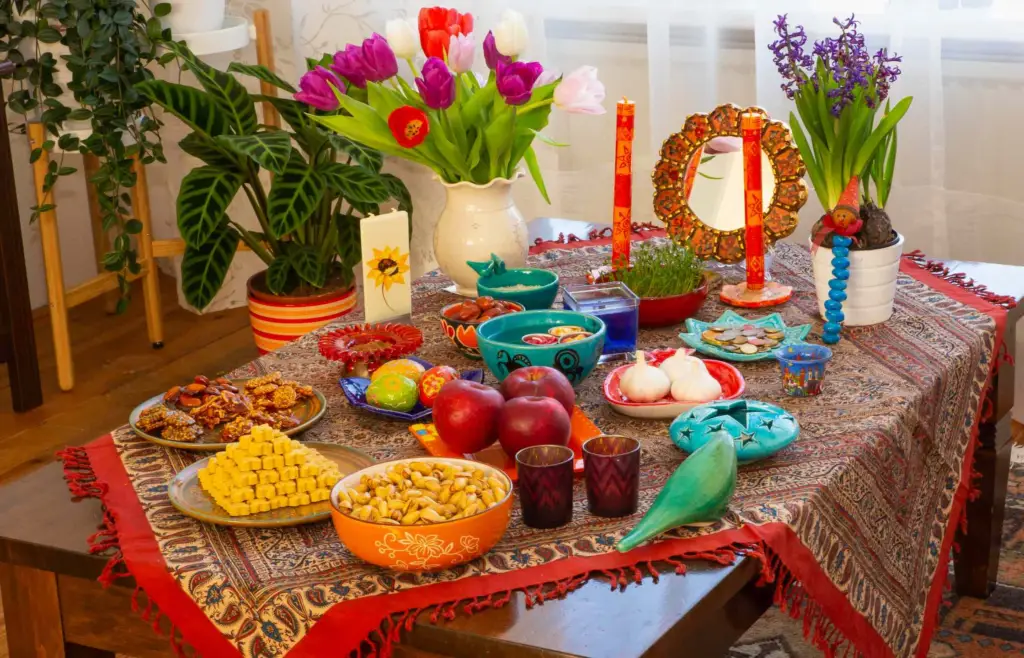
- Nowruz Feast: The Persian New Year, Nowruz, is celebrated with a grand feast featuring symbolic dishes like Sabzi Polo (herb rice) and Reshteh Polo (noodle rice).
- Yalda Night: Iranians celebrate the longest night of the year with family gatherings, enjoying foods like watermelon, nuts, and sweet treats.
Tea Culture
Iranians have a deep love for tea, often served strong and black, accompanied by sweets or dried fruits. Tea is a social glue, fostering conversations and warmth.
Hospitality and Etiquette
Iranians take immense pride in hospitality. Guests are considered a blessing, and hosts go to great lengths to ensure a bountiful and diverse spread for their visitors.
Modern Trends
While traditional dishes hold a special place, modern Iranian cuisine is witnessing innovations and fusions, reflecting global culinary trends.
Exploring Iranian food culture is not just a gustatory journey but a voyage through history, traditions, and the warmth of shared meals. From the tantalizing aroma of saffron to the intricate dance of flavors on the palate, Iranian cuisine invites all to savor its complexities and embrace the cultural richness it embodies.
Take Me to The Recipes
How Healthy is Iranian Food?
Iranian food, like any traditional cuisine, has both nutritional strengths and areas for improvement. Let’s explore its health aspects:
Balanced Diet and Nutrient-Rich Ingredients
- Whole Grains: Iranian cuisine heavily features whole grains, especially rice. Brown rice provides fiber, vitamins, and minerals.
- Legumes: Lentils, chickpeas, and beans are staples. They offer protein, fiber, and micronutrients.
- Herbs and Spices: Fresh herbs like parsley, mint, and coriander add flavor and antioxidants.
- Fruits and Nuts: Pomegranates, dates, and pistachios are common. They provide vitamins, healthy fats, and antioxidants.
Healthy Fats:
- Olive Oil: Used in cooking and dressings, it contains monounsaturated fats.
- Nuts and Seeds: Walnuts, almonds, and sesame seeds contribute healthy fats.
Protein Sources
- Lamb and Chicken: Common meats in Iranian dishes.
- Fish: Especially in coastal regions, fish provides omega-3 fatty acids.
Cultural Practices
- Slow Eating: Iranians often enjoy meals leisurely, promoting better digestion.
- Social Meals: Shared family meals foster social connections.
Challenges and Areas for Improvement
- Salt: Some traditional dishes can be high in salt.
- Sweets: Pastries and desserts are delicious but may contain added sugars.
- Portion Sizes: Large portions can lead to overeating.
Food Security and Wastage
- Food Security: Iran faces challenges related to food security, with millions experiencing food insecurity.
- Food Loss and Waste: Approximately 25 million tons of food are lost annually in Iran.
Nutrition Transition
- Obesity and Overweight: Prevalence of obesity and overweight is increasing among Iranian adults
- Dietary Shifts: As lifestyles change, traditional diets may be replaced by processed foods.
In summary, Iranian food offers a mix of wholesome ingredients, but moderation and awareness of portion sizes are essential for overall health. 🍽️
References
- Do Iranian households benefit from food according to their health characteristics?
- Shifting to a Sustainable Dietary Pattern in Iranian
- Understanding the Diets of Iranian Adults
Take Me to The Recipes
Traditional Iranian Cuisine: A Taste of Persia

Are you ready to experience the flavors of Iran? Let’s dive into the world of traditional Iranian dishes and explore the rich history of Persian recipes. Iranian culinary traditions have been passed down through generations, resulting in a diverse and exciting cuisine that has captivated taste buds around the world.
One dish you must try is Ghormeh Sabzi, an aromatic stew made with slow-cooked beef, kidney beans, and a mix of herbs that include parsley, scallions, and fenugreek. Another classic is Fesenjan, a sweet and savory dish made with pomegranate molasses, walnuts, and chicken or duck. And if you’re a fan of rice dishes, Chelo Kebab is a must-try with its succulent grilled meat served with fluffy saffron rice.
These traditional Iranian dishes are not just delicious, they also have cultural significance. For example, Chelo Kebab is often served during celebrations and special occasions, while Ghormeh Sabzi is a staple during the Persian New Year.
Take Me to The Recipes
Savor the Flavors of Iran – A Culinary Journey

What a journey it has been, exploring the mouthwatering delights of Iranian recipes! From traditional dishes to unique cooking techniques, we’ve delved into the depths of Persian cuisine and discovered the vibrant spices and ingredients that make it so special.
Through this culinary adventure, I hope you’ve gained an appreciation for Iranian food culture and the significance behind these beloved dishes. Persian cuisine is more than just food; it’s a reflection of Iranian history and traditions.
So, now that we’ve learned about the tantalizing flavors of Iranian cuisine, it’s time to bring them into your own kitchen. With the knowledge gained in our previous sections, you’ll be able to create authentic Iranian recipes in your own home.
One of the great things about Iranian cuisine is the use of fresh and fragrant ingredients. From saffron to dried limes, these unique ingredients add depth and complexity to Iranian recipes. You can find many of these ingredients at Middle Eastern specialty stores or online.
Some popular Iranian recipes to try at home include the aromatic stew of Ghormeh Sabzi, the flavorful rice dish of Chelo Kebab, and the delectable sweet and sour Pomegranate walnut stew known as Fesenjan.
As you cook up these Persian recipes in your own kitchen, let the aromas transport you to the vibrant streets of Iran. Savor the rich and diverse flavors of Iranian Cuisine and recipes and embrace the cultural significance that goes along with them.
Thank you for joining me on this culinary journey through Persian cuisine. I hope these recipes bring joy and unforgettable dining experiences to your table.
Take Me to The Recipes
Exploring Iranian Cooking Techniques

Iranian cuisine is famous for its unique and flavorful cooking techniques. These techniques have been used for centuries and have been passed down through generations, ensuring that the dishes retain their authenticity and cultural significance.
The slow-cooking method is a popular technique used in many Iranian stews, such as Ghormeh Sabzi and Gheymeh. These stews are cooked over a low flame for several hours, allowing the ingredients to meld together and create a rich and savory flavor.
Sautéing is another common technique used in Iranian cuisine. This method is used to cook aromatics, such as onions and garlic, as well as to sear meat and vegetables. The process involves heating oil or butter in a pan and adding the ingredients, cooking them until they are fragrant and golden brown.
Grilling is also a popular technique in Iranian cuisine, especially for kebabs. Meat, vegetables, and even fruits are marinated in a flavorful mixture of spices and grilled over hot coals, creating a charred and smoky flavor that is unique to this cooking method.
Persian cuisine also makes use of an array of unique ingredients, such as saffron, dried limes, and rosewater. These ingredients add depth and complexity to the dishes, creating a flavor profile that is unlike any other.
If you are looking to recreate the flavors of Iran in your own kitchen, incorporating these traditional cooking techniques and ingredients is key. With a little practice and experimentation, you can master the art of Iranian cuisine and impress your friends and family with your culinary skills.
Take Me to The Recipes
Iran National Dish
The Iranian cuisine has rich and diverse flavors, and one of its most famous dishes is the Iranian national dish is Chelo kebab.
Chelo kebab is a traditional Persian rice dish. Chefs serve it with grilled skewered meat, usually lamb or chicken. They cook the rice in a unique way, resulting in each grain being perfectly fluffy and separated. They marinate the kebab with a special blend of herbs and spices, giving it a delicious and aromatic taste.
It is often served with grilled tomatoes and butter, adding a burst of flavor to the dish. Chelo kebab is a symbol of Iranian culinary heritage and is enjoyed by locals and visitors alike.
Some say the popular Persian dish called Tahchin is the national dish. It features a flavorful combination of rice, yogurt, and saffron, often layered with chicken or meat. It is known for its crispy golden crust formed during cooking. Here’s a detailed recipe for Tahchin.
Choosing either one will delight your taste buds.!
Take Me to The Recipes
Popular Iranian Recipes

Iranian cuisine, known for its aromatic spices, rich flavors, and diverse range of dishes, has gained international acclaim. Here’s a journey into some of the most popular and iconic Iranian foods:
Chelow Kebab
- Description: A quintessential Iranian dish, Chelow Kebab consists of succulent, grilled meat—often lamb or chicken—served with fluffy saffron-infused rice. Grilled tomatoes and sumac are common accompaniments.
- Serving: Served during various occasions, Chelow Kebab showcases the art of Persian grilling and the mastery of rice preparation.
Ghormeh Sabzi
- Description: This herb-rich stew is a symbol of Iranian culinary excellence. It typically features lamb or beef, kidney beans, dried limes, and an abundance of fresh herbs like parsley, cilantro, and fenugreek.
- Serving: Ghormeh Sabzi is a popular dish for family gatherings and celebrations.
Fesenjan
- Description: Fesenjan is a unique and savory-sweet dish made with pomegranate molasses, ground walnuts, and poultry (chicken or duck). The combination of these ingredients results in a rich, complex flavor.
- Serving: Often served during special occasions and festive gatherings.
Tahchin
- Description: Tahchin is a delightful savory rice cake that combines yogurt, saffron, and either chicken or beef. The dish is known for its crispy golden crust and tender, flavorful interior.
- Serving: Enjoyed during family meals and celebrations.
Zereshk Polo ba Morgh
- Description: This aromatic dish features rice cooked with barberries (zereshk) and served with saffron-infused chicken. The tartness of barberries complements the fragrant rice and tender chicken.
- Serving: A popular choice for special occasions and feasts.
Ash Reshteh
- Description: A hearty and wholesome noodle soup, Ash Reshteh incorporates a variety of fresh herbs, legumes, and noodles. It is often garnished with kashk (whey) and mint.
- Serving: Traditionally enjoyed during Nowruz, the Persian New Year.
Dolma (Dolmeh)
- Description: Grape leaves stuffed with a mixture of rice, ground meat, and aromatic herbs, Dolma is a delicious and visually appealing dish. Variations include meat-filled and vegetarian options.
- Serving: A popular appetizer or main course.
Sabzi Polo Mahi
- Description: A festive dish for Nowruz, Sabzi Polo Mahi is herbed rice served with fish, often whitefish or smoked fish. The dish represents the renewal of nature during the New Year celebration.
- Serving: A Nowruz specialty.
Halva
- Description: A sweet treat made from various ingredients such as sesame paste, flour, or sunflower seeds, Halva is rich, dense, and often flavored with saffron or rosewater.
- Serving: Enjoyed as a dessert or sweet snack.
Persian Tea and Sweets
- Description: Iranians have a deep love for tea, typically served strong and black. Tea is often accompanied by a variety of sweets, including pastries, baklava, and traditional Persian cookies.
- Serving: An integral part of Iranian hospitality and social gatherings.
Iranian cuisine is a celebration of the country’s cultural heritage, and these popular dishes showcase the artistry and diversity embedded in Persian culinary traditions. Whether enjoyed at home or in Iranian restaurants around the world, these foods offer a tantalizing experience for the taste buds.
Bringing Iranian Cuisine to Your Kitchen
Now that we have explored the tantalizing flavors of Iranian cuisine, it’s time to bring them into your own kitchen. I have gathered some popular Iranian recipes that you can easily recreate at home, using authentic Persian ingredients for an authentic taste.
Iranian Food – Baghali Polo

A Culinary Voyage: Baghali Polo and the Persian Flair
Welcome to my kitchen, where we’re about to embark on a delightful journey with Baghali Polo, a classic Iranian dish that showcases the essence of Persian culinary artistry. Originating from Iran, Baghali Polo is a flavorful rice dish that combines the fragrant basmati rice with fresh dill, tender fava beans, and aromatic saffron.
Join me as we explore the rich history of this dish and bring the tastes of Iran to your table.
Iranian Food – Baghali Polo Ingredients
- 2 cups Basmati rice
- 1 cup fresh or frozen fava beans
- 1/2 cup chopped fresh dill
- 1/4 cup vegetable oil
- 1 large onion, finely chopped
- 1 teaspoon ground cumin
- 1 teaspoon ground coriander
- 1/2 teaspoon ground turmeric
- 1/2 teaspoon saffron threads (dissolved in 2 tablespoons hot water)
- Salt and pepper to taste
Iranian Food – Baghali Polo Recipe
1. Prepare the Rice:
- Rinse Basmati rice under cold water until the water runs clear.
- Soak rice in salted water for 30 minutes, then drain.
2. Blanch the Fava Beans:
- In a pot of boiling water, blanch the fava beans for 2-3 minutes.
- Drain and set aside.
3. Sauté the Aromatics:
- In a pan, heat vegetable oil over medium heat.
- Add finely chopped onions and sauté until golden brown.
4. Add Spices:
- Stir in ground cumin, coriander, turmeric, salt, and pepper to the sautéed onions.
- Cook for an additional 2 minutes until the spices release their aroma.
5. Combine Rice and Aromatics:
- Mix the soaked and drained rice into the pan with the sautéed spices, creating a flavorful base.
6. Add Fava Beans and Dill:
- Gently fold in the blanched fava beans and chopped fresh dill, ensuring an even distribution.
7. Steam with Saffron:
- In a large pot, layer the rice mixture and drizzle saffron water over the top.
- Cover and steam over low heat for 45-50 minutes, allowing the rice to cook and form a golden crust.
8. Fluff and Serve:
- Once cooked, gently fluff the rice with a fork.
- Serve Baghali Polo on a platter, ensuring a beautiful display of fava beans and dill.
Serving Information:
- Serves: 4
- Estimated Cooking Time: 1 hour
Nutritional Information:
- Calories per serving: 350 kcal
- Protein: 6g
- Fat: 8g
- Carbohydrates: 60g
- Fiber: 5g
Enjoy the aromatic symphony of Baghali Polo, a taste of Iran that captures the harmony of fragrant rice, dill, and fava beans on your plate!
Iranian Food – Polo Morgh

Savoring Tradition: Zereshk Polo Morgh, a Culinary Gem from Iran
Welcome to my kitchen, where we’re about to embark on a journey into the heart of Iranian cuisine with Zereshk Polo Morgh. Originating from Iran, this dish is a testament to the country’s rich culinary history. Zereshk Polo Morgh features a delightful blend of aromatic saffron rice, tart barberries, and succulent chicken, creating a symphony of flavors.
Let’s delve into the origins and craft this Iranian masterpiece.
Iranian Food – Zereshk Polo Morgh Ingredients
- 2 cups Basmati rice
- 1 whole chicken, cut into pieces
- 1 cup dried barberries (zereshk)
- 1 large onion, finely chopped
- 1/4 cup vegetable oil
- 1/2 teaspoon ground saffron (dissolved in 2 tablespoons hot water)
- 1 teaspoon ground turmeric
- Salt and pepper to taste
- 2 tablespoons butter (optional, for added richness)
- Sliced almonds for garnish (optional)
Iranian Food – Zereshk Polo Morgh Recipe
1. Prepare the Rice:
- Rinse Basmati rice under cold water until the water runs clear.
- Soak rice in salted water for 30 minutes, then drain.
2. Sauté the Aromatics:
- In a pot, heat vegetable oil over medium heat.
- Add finely chopped onions and sauté until golden brown.
3. Brown the Chicken:
- Add chicken pieces to the pot, season with ground turmeric, salt, and pepper.
- Brown the chicken on all sides, infusing the flavors into the dish.
4. Cook Barberries:
- In a separate pan, briefly sauté the dried barberries with a pinch of sugar until they plump up.
- Mix half of the saffron water into the barberries for added color.
5. Create Layers:
- In the pot with chicken, create a layer with half of the parboiled rice.
- Sprinkle half of the remaining saffron water over the rice.
- Add a layer of sautéed barberries and chicken.
- Repeat the process, finishing with a layer of rice on top.
6. Steam to Perfection:
- Drizzle melted butter and the remaining saffron water over the top.
- Cover and steam over low heat for 45-50 minutes, allowing the rice to cook and form a golden crust.
7. Garnish and Serve:
- Once cooked, check the seasoning and adjust if necessary.
- Serve Zereshk Polo Morgh on a platter, garnishing with sliced almonds if desired.
Serving Information:
- Serves: 4
- Estimated Cooking Time: 1.5 hours
Nutritional Information:
- Calories per serving: 500 kcal
- Protein: 30g
- Fat: 20g
- Carbohydrates: 60g
- Fiber: 5g
Delight in the flavors of Zereshk Polo Morgh, a dish that reflects the rich heritage of Iran and invites warmth to your dining table!
Iranian Food – Adasi

Adasi: A Hearty Taste of Iranian Comfort
Welcome to my kitchen, where we’re diving into the comforting flavors of Adasi, a classic Iranian dish that traces its roots through centuries of Persian culinary traditions. Originating from Iran, Adasi is a wholesome and nourishing lentil soup that reflects the simplicity and warmth of home-cooked meals.
Join me as we explore the history of this hearty dish and prepare a bowlful of Iranian comfort.
Iranian Food – Adasi Ingredients
- 1 cup brown or green lentils, rinsed
- 1 large onion, finely chopped
- 2 carrots, diced
- 2 celery stalks, chopped
- 3 cloves garlic, minced
- 2 tablespoons olive oil
- 1 teaspoon ground cumin
- 1 teaspoon ground coriander
- 1/2 teaspoon turmeric
- 6 cups vegetable or chicken broth
- Salt and pepper to taste
- Lemon wedges for serving
- Fresh parsley, chopped, for garnish
Iranian Food – Adasi Recipe
1. Sauté Aromatics:
- In a large pot, heat olive oil over medium heat.
- Add finely chopped onions, minced garlic, diced carrots, and chopped celery.
- Sauté until the vegetables are softened and aromatic.
2. Add Lentils and Spices:
- Incorporate rinsed lentils into the pot.
- Stir in ground cumin, coriander, and turmeric, allowing the spices to coat the lentils and vegetables.
3. Simmer with Broth:
- Pour in vegetable or chicken broth, bringing the mixture to a gentle boil.
- Reduce heat to low, cover, and simmer for 30-40 minutes until lentils are tender.
4. Season and Blend:
- Season the soup with salt and pepper to taste.
- Use an immersion blender to partially blend the soup, leaving some lentils and vegetables intact for texture.
5. Adjust Consistency:
- If the soup is too thick, add more broth until reaching your desired consistency.
- Simmer for an additional 10 minutes to let the flavors meld.
6. Serve and Garnish:
- Ladle Adasi into bowls.
- Squeeze fresh lemon juice over each serving.
- Garnish with chopped fresh parsley for a burst of freshness.
Serving Information:
- Serves: 6
- Estimated Cooking Time: 1 hour
Nutritional Information:
- Calories per serving: 180 kcal
- Protein: 10g
- Fat: 5g
- Carbohydrates: 25g
- Fiber: 8g
Indulge in the heartwarming flavors of Adasi, a taste of Iranian comfort that brings together the simplicity of lentils and a blend of aromatic spices!
Iranian Food – Mirza Ghasemi

Smoky Elegance: Unveiling the Legacy of Mirza Ghasemi in Northern Iran
Step into my kitchen, where we’re unraveling the culinary charm of Mirza Ghasemi, a traditional dish hailing from the Caspian region in Northern Iran.
Rooted in the lush landscapes and the bounty of the Caspian Sea, Mirza Ghasemi showcases the region’s rich agricultural produce and the smoky flavors of grilled eggplants.
Join me in exploring the history and crafting this delectable Persian appetizer that captures the essence of Northern Iranian cuisine.
Iranian Food – Mirza Ghasemi Ingredients
- 3 large eggplants
- 4 cloves garlic, minced
- 2 large tomatoes, diced
- 3 eggs
- 1 teaspoon ground turmeric
- 1 teaspoon ground cumin
- 1/2 teaspoon red pepper flakes (adjust to taste)
- Salt and pepper to taste
- 1/4 cup vegetable oil
- Fresh herbs (parsley or cilantro) for garnish
- Persian flatbread (lavash or sangak) for serving
Iranian Food – Mirza Ghasemi Recipe
1. Roast Eggplants:
- Preheat the oven to 400°F (200°C).
- Place whole eggplants on a baking sheet and roast for 45-50 minutes until the skin is charred and the flesh is soft.
2. Peel and Mash:
- Allow the roasted eggplants to cool.
- Peel off the charred skin and mash the flesh in a bowl.
3. Sauté Garlic and Tomatoes:
- In a pan, heat vegetable oil over medium heat.
- Sauté minced garlic until fragrant, then add diced tomatoes and cook until softened.
4. Add Spices:
- Stir in ground turmeric, ground cumin, red pepper flakes, salt, and pepper.
- Cook for an additional 5 minutes until the spices are well-incorporated.
5. Mix in Eggplant:
- Add the mashed eggplant to the pan, mixing it thoroughly with the tomato and spice mixture.
- Cook for another 10-15 minutes until the flavors meld.
6. Introduce Eggs:
- Create wells in the eggplant mixture and crack the eggs into them.
- Cover and cook until the eggs are cooked to your liking.
7. Garnish and Serve:
- Garnish Mirza Ghasemi with fresh herbs.
- Serve with Persian flatbread for dipping.
Serving Information:
- Serves: 4
- Estimated Cooking Time: 1 hour
Nutritional Information:
- Calories per serving: 250 kcal
- Protein: 8g
- Fat: 15g
- Carbohydrates: 25g
- Fiber: 10g
Indulge in the smoky elegance of Mirza Ghasemi, a dish that brings the flavors of Northern Iran straight to your table!
Iranian Food – Kashke Bademjan

Exploring Iranian Delicacy: The Rich History of Kashke Bademjan
Step into my kitchen, where we’re about to embark on a culinary journey through the flavorful history of Kashke Bademjan, a classic Persian dish that hails from Iran.
This delightful appetizer showcases the rich, velvety texture of eggplant blended with a tangy yogurt-based sauce, creating a symphony of flavors that captures the essence of Iranian cuisine.
Join me as we delve into the heritage of Kashke Bademjan and craft this savory delight.
Iranian Food – Kashke Bademjan Ingredients
- 2 large eggplants
- 1 cup Kashk (whey), available at Middle Eastern grocery stores
- 1 cup Greek yogurt
- 2 cloves garlic, minced
- 1/4 cup chopped mint leaves
- 2 tablespoons olive oil
- Salt and pepper to taste
- Walnuts, chopped, for garnish
- Pomegranate seeds, for garnish (optional)
Iranian Food – Kashke Bademjan Recipe
1. Roast Eggplants:
- Preheat the oven to 400°F (200°C).
- Place whole eggplants on a baking sheet and roast for 45-50 minutes until the skin is charred and the flesh is soft.
2. Peel and Mash:
- Allow the roasted eggplants to cool.
- Peel off the charred skin and mash the flesh in a bowl.
3. Create Kashk-Yogurt Mixture:
- In a separate bowl, combine Kashk, Greek yogurt, minced garlic, chopped mint, and olive oil.
- Mix well until you achieve a smooth consistency.
4. Blend Eggplant and Sauce:
- Gradually add the mashed eggplant to the Kashk-yogurt mixture, blending thoroughly.
- Season with salt and pepper to taste.
5. Garnish and Chill:
- Transfer the mixture to a serving dish.
- Garnish with chopped walnuts and pomegranate seeds if desired.
- Refrigerate for at least 30 minutes to allow the flavors to meld.
6. Serve and Enjoy:
- Serve Kashke Bademjan chilled with warm pita or bread for dipping.
Serving Information:
- Serves: 4
- Estimated Cooking Time: 1 hour
Nutritional Information:
- Calories per serving: 220 kcal
- Protein: 8g
- Fat: 15g
- Carbohydrates: 18g
- Fiber: 7g
Dive into the creamy elegance of Kashke Bademjan, a tantalizing appetizer that encapsulates the essence of Iranian culinary artistry!
Iranian Food – Albaloo Polo

Unveiling Albaloo Polo: A Symphony of Tart and Sweet from Iran
Step into my kitchen, where we’re about to embark on a culinary adventure exploring the vibrant flavors of Albaloo Polo, a Persian dish that beautifully combines tart cherries with fragrant saffron-infused rice. Originating from Iran,
Albaloo Polo reflects the country’s love for the juxtaposition of sweet and sour notes, creating a dish that dances on the taste buds. Join me in unraveling the history and crafting this delightful Persian creation.
Iranian Food – Albaloo Polo Ingredients
- 2 cups Basmati rice
- 1 cup sour cherries, pitted (frozen or canned)
- 1 cup chicken, cooked and shredded
- 1 large onion, finely chopped
- 1/4 cup vegetable oil
- 1/2 teaspoon ground saffron (dissolved in 2 tablespoons hot water)
- 1 teaspoon ground cinnamon
- 1/2 teaspoon ground cardamom
- 1/4 cup slivered almonds
- Salt and pepper to taste
Iranian Food – Albaloo Polo Recipe
1. Prepare the Rice:
- Rinse Basmati rice under cold water until the water runs clear.
- Soak rice in salted water for 30 minutes, then drain.
2. Sauté the Aromatics:
- In a pot, heat vegetable oil over medium heat.
- Add finely chopped onions and sauté until golden brown.
3. Add Shredded Chicken:
- Incorporate cooked and shredded chicken into the pot.
- Cook for an additional 5 minutes until the chicken is well-coated with the sautéed onions.
4. Layering the Rice:
- In the pot, create a layer with half of the parboiled rice.
- Sprinkle half of the saffron water, ground cinnamon, and ground cardamom over the rice.
- Add a layer of sour cherries and shredded chicken.
- Repeat the process, finishing with a layer of rice on top.
5. Steam to Perfection:
- Drizzle the remaining saffron water over the top layer.
- Cover and steam over low heat for 45-50 minutes, allowing the rice to cook and form a golden crust.
6. Toast Almonds:
- In a small pan, toast slivered almonds until lightly browned.
7. Serve and Garnish:
- Once cooked, fluff the rice with a fork.
- Serve Albaloo Polo on a platter, garnishing with toasted almonds.
Serving Information:
- Serves: 4
- Estimated Cooking Time: 1 hour
Nutritional Information:
- Calories per serving: 400 kcal
- Protein: 15g
- Fat: 15g
- Carbohydrates: 50g
- Fiber: 4g
Indulge in the luscious combination of sweet and tart with Albaloo Polo, a dish that encapsulates the heart and soul of Persian cuisine!
Iranian Food – Sosis Bandari

Embracing Flavors: Sosis Bandari and the Iranian Street Food Tale
Join me in my kitchen as we explore the vibrant world of Iranian street food with Sosis Bandari. Originating from the bustling streets of Iran, this savory delight is a fusion of Middle Eastern and Persian flavors, showcasing the influence of global culinary encounters.
Sosis Bandari is a beloved street food that features grilled sausages served with a spicy tomato-based sauce, creating a symphony of tastes that will transport you to the lively markets of Iran.
Iranian Food – Sosis Bandari Ingredients
- 6 beef or chicken sausages
- 1 large onion, finely chopped
- 2 cloves garlic, minced
- 1 cup tomato puree
- 1 tablespoon tomato paste
- 1 teaspoon ground cumin
- 1 teaspoon paprika
- 1/2 teaspoon chili powder (adjust to taste)
- 1 tablespoon olive oil
- Salt and pepper to taste
- Fresh parsley, chopped, for garnish
Iranian Food – Sosis Bandari Recipe
1. Grill the Sausages:
- Preheat the grill or a grill pan.
- Grill the sausages until cooked through and slightly charred. Set aside.
2. Sauté Aromatics:
- In a pan, heat olive oil over medium heat.
- Sauté finely chopped onions and minced garlic until golden brown.
3. Create the Tomato Sauce:
- Add tomato puree and tomato paste to the sautéed aromatics.
- Stir in ground cumin, paprika, and chili powder.
- Season with salt and pepper to taste.
4. Simmer the Sauce:
- Allow the tomato sauce to simmer for 15-20 minutes, letting the flavors meld.
5. Coat the Sausages:
- Add grilled sausages to the tomato sauce, ensuring they are well-coated.
- Simmer for an additional 5-7 minutes.
6. Serve and Garnish:
- Place the sausages on a serving plate.
- Pour the tomato sauce over the sausages.
- Garnish with freshly chopped parsley for a burst of freshness.
Serving Information:
- Serves: 3-4
- Estimated Cooking Time: 30 minutes
Nutritional Information:
- Calories per serving: 300 kcal
- Protein: 15g
- Fat: 20g
- Carbohydrates: 10g
- Fiber: 2g
Immerse yourself in the lively street food experience with Sosis Bandari, a dish that brings together the bold flavors of Iran and the international influences of its culinary journey!
Iranian Food – Kookoo Sabzi

Heritage on a Plate: The Culinary Tale of Kookoo Sabzi in Iran
Welcome to my kitchen, where we’re diving into the rich culinary heritage of Iran with the iconic Kookoo Sabzi. This delightful Persian herb frittata showcases a medley of fresh herbs, creating a vibrant and flavorful dish that has been enjoyed for generations.
Join me as we explore the history and craft this traditional Iranian delicacy, connecting with the heart of Persian cuisine.
Iranian Food – Kookoo Sabzi Ingredients
- 2 cups mixed fresh herbs (parsley, cilantro, dill, and chives), finely chopped
- 1 cup spinach, chopped
- 4 large eggs
- 1 teaspoon baking powder
- 1 tablespoon all-purpose flour
- 1 tablespoon barberries (zereshk), soaked
- 1/2 cup walnuts, chopped
- 1 onion, finely chopped
- 2 cloves garlic, minced
- 1/2 teaspoon ground turmeric
- Salt and pepper to taste
- Vegetable oil for frying
Iranian Food – Kookoo Sabzi Recipe
1. Prepare the Herbs:
- Finely chop a mix of fresh herbs including parsley, cilantro, dill, and chives.
- Chop spinach and soak barberries in warm water.
2. Sauté Aromatics:
- In a pan, sauté finely chopped onions until golden brown.
- Add minced garlic and sauté for an additional minute.
3. Mix the Batter:
- In a large bowl, whisk eggs and add baking powder, all-purpose flour, and ground turmeric.
- Mix in the sautéed onions, garlic, and the chopped herbs.
- Fold in chopped spinach, soaked barberries, and chopped walnuts.
- Season with salt and pepper.
4. Fry the Kookoo Sabzi:
- Heat vegetable oil in a pan over medium heat.
- Pour the batter into the pan, spreading it evenly.
- Cook for 10-12 minutes on each side until golden brown and cooked through.
5. Serve and Enjoy:
- Once cooked, slide the Kookoo Sabzi onto a serving plate.
- Cut into wedges and serve warm.
Serving Information:
- Serves: 4
- Estimated Cooking Time: 30 minutes
Nutritional Information:
- Calories per serving: 200 kcal
- Protein: 8g
- Fat: 15g
- Carbohydrates: 10g
- Fiber: 3g
Delight in the freshness and vibrancy of Kookoo Sabzi, a dish that encapsulates the essence of Iranian cuisine and invites a burst of flavor to your table!
Iranian Food – Khoresht Karafs

Green Elegance: The Timeless Tale of Khoresht Karafs in Iran
Step into my kitchen as we uncover the rich history of Khoresht Karafs, a traditional Iranian celery stew that has graced tables for generations.
Originating from Iran, this aromatic dish marries the subtle flavors of celery with tender chunks of meat, creating a comforting stew that reflects the heart and soul of Persian cuisine.
Join me on this culinary journey, and let’s craft a dish that resonates with the warmth of Iranian hospitality.
Iranian Food – Khoresht Karafs Ingredients
- 1 pound lamb or beef, cubed
- 2 cups celery, sliced
- 1 large onion, finely chopped
- 2 tablespoons vegetable oil
- 1 cup fresh parsley, chopped
- 1 cup fresh mint, chopped
- 2 tablespoons dried fenugreek leaves (shanbalileh), crushed
- 1 teaspoon ground turmeric
- 1 teaspoon ground cinnamon
- 1 teaspoon ground black lime (limoo amani) or 1 tablespoon lime juice
- Salt and pepper to taste
- 1 tablespoon tomato paste
- 2 cups water
- 1 tablespoon sugar (optional)
Iranian Food – Khoresht Karafs Recipe
1. Sauté the Meat:
- In a pot, heat vegetable oil over medium heat.
- Add cubed lamb or beef, and sauté until browned.
2. Sauté Aromatics:
- Add finely chopped onions to the pot and sauté until golden brown.
- Stir in ground turmeric, ground cinnamon, and tomato paste.
3. Add Herbs:
- Incorporate chopped fresh parsley and mint into the pot.
- Add dried fenugreek leaves, crushed for an aromatic touch.
4. Introduce Celery:
- Stir in sliced celery, ensuring it’s well-coated with the aromatic mixture.
5. Season and Simmer:
- Season the stew with salt, pepper, and ground black lime (or lime juice).
- Pour in 2 cups of water and bring the stew to a gentle boil.
- Cover and simmer over low heat for 1 to 1.5 hours until the meat is tender.
6. Adjust Sweetness:
- Optional: Add sugar to balance the flavors. Adjust based on personal preference.
7. Serve and Enjoy:
- Once cooked, check the seasoning and adjust if necessary.
- Serve Khoresht Karafs over steamed rice.
Serving Information:
- Serves: 4
- Estimated Cooking Time: 1.5 hours
Nutritional Information:
- Calories per serving: 350 kcal
- Protein: 20g
- Fat: 15g
- Carbohydrates: 25g
- Fiber: 8g
Indulge in the savory allure of Khoresht Karafs, a dish that encapsulates the heartiness and aromatic charm of Iranian cooking!
Iranian Food – Estamboli Polo

Journey to Flavor: Estamboli Polo and the Culinary Odyssey in Iran
Welcome to my kitchen, where we’re about to embark on a delightful adventure with Estamboli Polo, a classic Iranian dish that traces its roots to the bustling streets of Tehran.
Originating from the Iranian capital, this flavorful rice dish combines ground meat with tomatoes and aromatic spices, creating a symphony of tastes that will transport you straight to the heart of Persian culinary traditions.
Join me as we explore the history of Estamboli Polo and craft a dish that’s both rich in heritage and taste.
Iranian Food – Estamboli Polo Ingredients
- 2 cups Basmati rice
- 1 pound ground beef or lamb
- 4 large tomatoes, grated
- 1 large onion, finely chopped
- 2 tablespoons tomato paste
- 1 teaspoon ground turmeric
- 1 teaspoon ground cumin
- 1 teaspoon ground cinnamon
- 1/2 teaspoon red pepper flakes (adjust to taste)
- 1/4 cup vegetable oil
- Salt and pepper to taste
- 1 tablespoon sugar (optional, to balance acidity)
- 2 tablespoons butter (optional, for added richness)
Iranian Food – Estamboli Polo Recipe
1. Prepare the Rice:
- Rinse Basmati rice under cold water until the water runs clear.
- Soak rice in salted water for 30 minutes, then drain.
2. Sauté Aromatics:
- In a pot, heat vegetable oil over medium heat.
- Add finely chopped onions and sauté until golden brown.
3. Cook Ground Meat:
- Add ground beef or lamb to the pot and cook until browned.
- Stir in ground turmeric, ground cumin, and ground cinnamon.
4. Introduce Tomatoes:
- Grate fresh tomatoes and add them to the pot.
- Stir in tomato paste, red pepper flakes, salt, and pepper.
- Optional: Add sugar to balance the acidity.
5. Simmer and Infuse Flavors:
- Allow the tomato and meat mixture to simmer for 20-25 minutes.
- Adjust the seasoning to taste.
6. Parboil the Rice:
- In a separate pot, parboil the soaked rice until it’s slightly undercooked.
- Drain the rice.
7. Layer and Steam:
- In the pot with the tomato and meat mixture, create a layer with half of the parboiled rice.
- Repeat with another layer of tomato and meat mixture and finish with a layer of rice on top.
- Optional: Add butter in between the layers.
- Cover and steam over low heat for 45-50 minutes.
8. Serve and Enjoy:
- Once cooked, gently fluff the rice with a fork.
- Serve Estamboli Polo on a platter, ensuring the layers are visible.
Serving Information:
- Serves: 4
- Estimated Cooking Time: 1.5 hours
Nutritional Information:
- Calories per serving: 400 kcal
- Protein: 20g
- Fat: 15g
- Carbohydrates: 50g
- Fiber: 5g
Immerse yourself in the captivating flavors of Estamboli Polo, a dish that encapsulates the culinary charm of Iran and invites you on a savory journey!
Iranian Food – Khoresht Fesenjan

A Tapestry of Tastes: Unraveling the History of Khoresht Fesenjan in Iran
Welcome to my kitchen, where we’re delving into the rich culinary tapestry of Iran with Khoresht Fesenjan. Originating from Persian kitchens, this iconic dish is a celebration of sweet and savory flavors, combining ground walnuts and pomegranate molasses to create a luscious and aromatic stew.
Join me as we explore the history and craft a dish that resonates with the depth of Iranian gastronomy.
Iranian Food – Khoresht Fesenjan Ingredients
- 1.5 pounds chicken or duck, cut into pieces
- 2 cups walnuts, finely ground
- 2 cups pomegranate molasses
- 1 large onion, finely chopped
- 2 tablespoons vegetable oil
- 1 teaspoon ground cinnamon
- 1/2 teaspoon ground turmeric
- 1/2 teaspoon ground nutmeg
- 1/2 teaspoon ground cloves
- 2 tablespoons sugar (optional, for sweetness)
- Salt and pepper to taste
Iranian Food – Khoresht Fesenjan Recipe
1. Sauté Aromatics:
- In a pot, heat vegetable oil over medium heat.
- Add finely chopped onions and sauté until golden brown.
2. Brown the Chicken:
- Add chicken or duck pieces to the pot, browning them on all sides.
3. Add Ground Walnuts:
- Incorporate finely ground walnuts into the pot, stirring to coat the meat.
4. Spice it Up:
- Sprinkle ground cinnamon, ground turmeric, ground nutmeg, and ground cloves over the meat and walnut mixture.
5. Pour Pomegranate Molasses:
- Pour pomegranate molasses over the meat and walnuts, ensuring they are well-covered.
6. Simmer to Perfection:
- Season the stew with salt and pepper to taste.
- Optional: Add sugar for sweetness.
- Cover and simmer over low heat for 1.5 to 2 hours until the meat is tender.
7. Adjust Consistency:
- If the stew is too thick, add water to achieve the desired consistency.
- Simmer for an additional 15-20 minutes.
8. Serve and Enjoy:
- Once cooked, check the seasoning and adjust if necessary.
- Serve Khoresht Fesenjan over steamed rice.
Serving Information:
- Serves: 4
- Estimated Cooking Time: 2 hours
Nutritional Information:
- Calories per serving: 400 kcal
- Protein: 25g
- Fat: 30g
- Carbohydrates: 15g
- Fiber: 4g
Delight in the harmony of sweet and savory with Khoresht Fesenjan, a dish that embodies the essence of Iranian culinary artistry!
Iranian Food – Chelow Kebab

A quintessential Iranian dish, Chelow Kebab consists of succulent, grilled meat—often lamb or chicken—served with fluffy saffron-infused rice. Grilled tomatoes and sumac are common accompaniments.
Iranian Food Delight: Chelow Kebab
History and Background: Iranian cuisine is a tapestry of flavors, and at the heart of it lies the beloved Chelow Kebab. Originating from the vibrant streets of Iran, this dish reflects the rich culinary history of the region.
Chelow Kebab is a national treasure, often associated with festive occasions and family gatherings. The dish typically consists of fragrant saffron-infused rice paired with succulent grilled kebabs, creating a symphony of taste that captivates the senses.
Iranian Food – Chelow Kebab Ingredients
- 2 cups Basmati rice
- 500g lamb or beef, cubed
- 1 large onion, grated
- 1/4 cup plain yogurt
- 1 teaspoon saffron threads
- 1/4 cup melted butter
- Salt and pepper to taste
Kebab Marinade:
- 2 cloves garlic, minced
- 1 teaspoon ground turmeric
- 1 teaspoon ground cumin
- 1 teaspoon paprika
- 2 tablespoons olive oil
- Salt and pepper to taste
Iranian Food – Chelow Kebab Recipe
1. Marinating the Meat:
- In a bowl, combine the cubed meat with grated onion, yogurt, minced garlic, turmeric, cumin, paprika, olive oil, salt, and pepper.
- Mix well, ensuring the meat is evenly coated. Allow it to marinate for at least 2 hours or overnight for enhanced flavor.
2. Saffron Infusion:
- Soak saffron threads in a couple of tablespoons of hot water. Let it sit for 15-20 minutes until a deep, golden color develops.
3. Cooking the Rice:
- Rinse the Basmati rice under cold water until the water runs clear.
- Boil a large pot of water, add salt, and cook the rice until it’s almost fully cooked. Drain.
4. Grilling the Kebabs:
- Thread the marinated meat onto skewers.
- Grill the kebabs over medium heat until cooked to your liking, basting with saffron-infused water.
5. Saffron Butter Rice:
- In a large pot, melt butter and add the soaked saffron mixture. Layer the par-cooked rice on top.
- Drizzle saffron-infused water over the rice. Cover and let it steam on low heat until fully cooked.
6. Serving:
- Fluff the saffron rice and serve it alongside the grilled kebabs.
Serving Size: This recipe serves 4 people.
Cooking Time: Approximately 1.5 hours (including marination time and grilling).
Nutritional Information: Per Serving:
- Calories: 550 kcal
- Protein: 25g
- Carbohydrates: 60g
- Fat: 24g
Chelow Kebab is a celebration on a plate, inviting you to experience the exquisite blend of spices and textures that make Iranian cuisine truly exceptional. Enjoy this culinary journey from the comfort of your home!
Iranian Food – Ghormeh Sabzi

This herb-rich stew is a symbol of Iranian culinary excellence. It typically features lamb or beef, kidney beans, dried limes, and an abundance of fresh herbs like parsley, cilantro, and fenugreek.
The Rich Heritage of Ghormeh Sabzi: A Taste of Iran
Welcome to my cozy kitchen, where I love sharing delightful recipes from around the world. Today, let’s embark on a culinary journey to Iran, exploring the rich history and vibrant flavors of Ghormeh Sabzi.
This traditional Persian stew is a celebration of fresh herbs, tender meat, and a symphony of spices. Originating from the heart of Iran, Ghormeh Sabzi has been cherished for generations, passed down through families as a symbol of warmth and togetherness.
Iranian Food – Ghormeh Sabzi Ingredients:
- 1 pound lamb or beef, cut into bite-sized pieces
- 2 cups chopped parsley
- 1 cup chopped cilantro
- 1/2 cup chopped chives
- 1/2 cup chopped fenugreek leaves (or substitute with spinach)
- 4 cloves garlic, minced
- 1 large onion, finely chopped
- 1 tablespoon dried fenugreek (optional)
- 1 can (15 oz) red kidney beans, drained and rinsed
- 1 tablespoon tomato paste
- 2 dried limes (limoo amani), pierced
- 1 teaspoon ground turmeric
- 1 teaspoon ground cumin
- 1/2 teaspoon ground cinnamon
- Salt and pepper to taste
- 3 tablespoons vegetable oil
- 4 cups water
Iranian Food – Ghormeh Sabzi Recipe
1. Prepare the Ingredients:
- Wash and chop all the fresh herbs – parsley, cilantro, chives, and fenugreek leaves.
- Mince the garlic and finely chop the onion.
- If using fresh fenugreek leaves, wash and chop them. If not available, spinach can be a great substitute.
- Pierce the dried limes with a fork.
2. Sauté the Aromatics:
- In a large pot, heat vegetable oil over medium heat.
- Add chopped onions and minced garlic, sauté until golden brown.
3. Brown the Meat:
- Add the meat to the pot, and brown on all sides.
- Season with turmeric, cumin, cinnamon, salt, and pepper.
4. Build the Base:
- Stir in the tomato paste and cook for 2 minutes.
- Add the chopped herbs and fenugreek (or spinach), continuing to sauté until the herbs are wilted.
5. Simmer to Perfection:
- Pour in water, add pierced dried limes, and bring to a gentle boil.
- Reduce heat, cover, and simmer for 1.5 to 2 hours, or until the meat is tender.
6. Add Finishing Touches:
- Stir in drained kidney beans and simmer for an additional 15 minutes.
- Adjust seasoning to taste and remove the dried limes before serving.
Serving Information:
- Serves: 4
- Estimated Cooking Time: 2 hours and 30 minutes
Nutritional Information:
- Calories per serving: 400 kcal
- Protein: 25g
- Fat: 20g
- Carbohydrates: 30g
- Fiber: 8g
Enjoy the aromatic and flavorful Ghormeh Sabzi, a taste of Iran that brings people together around the dining table!
Iranian Food – Fesenjan

Fesenjan is a unique and savory-sweet dish made with pomegranate molasses, ground walnuts, and poultry (chicken or duck). The combination of these ingredients results in a rich, complex flavor.
Unveiling the Rich Tapestry of Fesenjan: A Culinary Gem from Iran
Welcome to my kitchen, where we embark on a gastronomic journey, discovering the exquisite flavors of Fesenjan. Originating from the heart of Iran, this traditional Persian dish is a testament to the country’s rich culinary heritage.
Fesenjan boasts a unique blend of sweet and savory, combining pomegranate molasses, ground walnuts, and succulent chicken. Let’s dive into the history and savor the essence of Iran through this delightful recipe.
Iranian Food – Fesenjan Ingredients
- 1 whole chicken, cut into pieces
- 2 cups ground walnuts
- 1 cup pomegranate molasses
- 1 large onion, finely chopped
- 1/4 cup vegetable oil
- 1 teaspoon ground cinnamon
- 1/2 teaspoon ground turmeric
- Salt and pepper to taste
- 1 tablespoon sugar (optional, for added sweetness)
- 2 cups water
- Pomegranate seeds for garnish (optional)
Iranian Food – Fesenjan Recipe
1. Prepare the Chicken:
- Cut the whole chicken into pieces, ensuring it is cleaned and pat dry.
2. Sauté the Aromatics:
- In a large pot, heat vegetable oil over medium heat.
- Add finely chopped onions and sauté until golden brown.
3. Brown the Chicken:
- Add chicken pieces to the pot and brown on all sides.
- Season with ground cinnamon, turmeric, salt, and pepper.
4. Create the Walnut-Pomegranate Base:
- In a separate bowl, mix ground walnuts, pomegranate molasses, and sugar (if using).
- Add the walnut-pomegranate mixture to the pot, coating the chicken evenly.
5. Simmer to Perfection:
- Pour in water, bring to a gentle boil, then reduce heat to simmer.
- Cover and cook for 1.5 to 2 hours, allowing the flavors to meld and the chicken to become tender.
6. Garnish and Serve:
- Once cooked, check the seasoning and adjust if necessary.
- Serve Fesenjan over steamed rice, garnishing with pomegranate seeds for a burst of freshness.
Serving Information:
- Serves: 4
- Estimated Cooking Time: 2 hours
Nutritional Information:
- Calories per serving: 500 kcal
- Protein: 30g
- Fat: 35g
- Carbohydrates: 20g
- Fiber: 5g
Indulge in the luscious harmony of Fesenjan, a dish that captures the soul of Iranian cuisine and invites warmth to your dining table!
Iranian Food – Zereshk Polo ba Morgh

This aromatic dish features rice cooked with barberries (zereshk) and served with saffron-infused chicken. The tartness of barberries complements the fragrant rice and tender chicken.
Journey to Iran’s Culinary Heritage: Zereshk Polo ba Morgh
Step into my kitchen, where we’re set to explore the delightful flavors of Zereshk Polo ba Morgh, a classic Iranian dish that encapsulates the essence of Persian cuisine. Originating from Iran, this dish is a perfect harmony of fragrant saffron rice, tart barberries, and succulent chicken.
Let’s dive into the history and savor the cultural richness of Iran through this flavorful recipe.
Iranian Food – Zereshk Polo ba Morgh Ingredients
- 2 cups Basmati rice
- 1 whole chicken, cut into pieces
- 1 cup dried barberries (zereshk)
- 1 large onion, finely chopped
- 1/4 cup vegetable oil
- 1/2 teaspoon ground saffron (dissolved in 2 tablespoons hot water)
- 1 teaspoon ground turmeric
- Salt and pepper to taste
- 2 tablespoons butter (optional)
- Sliced almonds for garnish (optional)
Iranian Food – Zereshk Polo ba Morgh Recipe
1. Prepare the Rice:
- Rinse Basmati rice under cold water until the water runs clear.
- Soak rice in salted water for 30 minutes, then drain.
2. Sauté the Aromatics:
- In a pot, heat vegetable oil over medium heat.
- Add finely chopped onions and sauté until golden brown.
3. Brown the Chicken:
- Add chicken pieces to the pot, season with ground turmeric, salt, and pepper.
- Brown the chicken on all sides, creating a flavorful base.
4. Cook the Barberries:
- In a separate pan, briefly sauté the dried barberries with a pinch of sugar until they plump up.
- Mix half of the saffron water into the barberries for added color.
5. Parboil the Rice:
- Bring a large pot of salted water to a boil.
- Add the soaked and drained rice, parboil for 6-8 minutes until slightly tender but not fully cooked.
- Drain the rice.
6. Layering and Steaming:
- In the pot with chicken, create a layer with half of the parboiled rice.
- Sprinkle half of the remaining saffron water over the rice.
- Add a layer of sautéed barberries and chicken.
- Repeat the process, finishing with a layer of rice.
7. Steam to Perfection:
- Make a few holes in the rice with the back of a spoon.
- Drizzle melted butter and the remaining saffron water over the top.
- Cover and steam over low heat for 45-50 minutes, allowing the rice to cook and form a golden crust.
8. Serve and Garnish:
- Gently fluff the rice with a fork.
- Serve Zereshk Polo ba Morgh on a platter, garnishing with sliced almonds if desired.
Serving Information:
- Serves: 4
- Estimated Cooking Time: 2 hours
Nutritional Information:
- Calories per serving: 600 kcal
- Protein: 30g
- Fat: 20g
- Carbohydrates: 80g
- Fiber: 5g
Immerse yourself in the flavors of Zereshk Polo ba Morgh, a culinary journey that brings the heart of Iran to your dining table!
Iranian Food – Ash Reshteh

A hearty and wholesome noodle soup, Ash Reshteh incorporates a variety of fresh herbs, legumes, and noodles. It is often garnished with kashk (whey) and mint.
Exploring Iranian Comfort: Ash Reshteh’s Heritage and Warmth
Step into my kitchen, where we’re about to uncover the heartwarming history of Ash Reshteh, a cherished Iranian soup that’s both comforting and rich in tradition. Originating from Iran, Ash Reshteh is a soul-soothing dish with a blend of noodles, beans, and vibrant herbs, creating a symphony of flavors.
Join me on this culinary journey as we embrace the cultural roots of Iran through the preparation of this hearty soup.
Iranian Food – Ash Reshteh Ingredients
- 1 cup lentils, rinsed
- 1/2 cup chickpeas, soaked overnight
- 1/2 cup red kidney beans, soaked overnight
- 1 cup chopped spinach
- 1 cup chopped parsley
- 1 cup chopped cilantro
- 1/2 cup chopped green onions
- 1/2 cup chopped dill
- 1/2 cup chopped chives
- 1 cup reshteh (Persian noodles) or linguini, broken into smaller pieces
- 1 large onion, finely chopped
- 4 cloves garlic, minced
- 2 tablespoons vegetable oil
- 1 tablespoon ground turmeric
- Salt and pepper to taste
- 1 tablespoon dried mint (for garnish)
- Kashk (whey) or Greek yogurt for topping
Iranian Food – Ash Reshteh Recipe
1. Prepare the Legumes:
- In a large pot, combine lentils, chickpeas, and kidney beans with enough water.
- Bring to a boil, then reduce heat and simmer until legumes are tender (approximately 1 hour).
2. Sauté Aromatics:
- In a separate pan, heat vegetable oil over medium heat.
- Add finely chopped onions and minced garlic, sauté until golden brown.
3. Incorporate Turmeric:
- Stir in ground turmeric, coating the onions and garlic with its golden hue.
4. Add Chopped Herbs:
- Add spinach, parsley, cilantro, green onions, dill, and chives to the sautéed mixture.
- Cook until the greens are wilted.
5. Cook Reshteh:
- In a separate pot, cook reshteh or linguini according to package instructions.
- Drain and set aside.
6. Combine and Season:
- Add the cooked legumes to the pot of sautéed herbs.
- Incorporate the cooked reshteh or linguini.
- Season with salt and pepper to taste.
7. Simmer to Blend:
- Allow the soup to simmer for an additional 15-20 minutes, letting the flavors meld.
8. Serve and Garnish:
- Ladle the Ash Reshteh into bowls.
- Top with a dollop of kashk or Greek yogurt.
- Sprinkle dried mint over each serving.
Serving Information:
- Serves: 6
- Estimated Cooking Time: 2 hours
Nutritional Information:
- Calories per serving: 350 kcal
- Protein: 15g
- Fat: 8g
- Carbohydrates: 60g
- Fiber: 10g
Dive into the heartwarming flavors of Ash Reshteh, a bowl of Iranian comfort that transcends time and brings joy to your home!
Iranian Food – Dolma (Dolmeh)

Grape leaves stuffed with a mixture of rice, ground meat, and aromatic herbs, Dolma is a delicious and visually appealing dish. Variations include meat-filled and vegetarian options.
Unwrapping the Culinary Tradition: Dolma’s Iranian Roots
Welcome to my kitchen, where we embark on a culinary adventure exploring the rich heritage of Dolma, a beloved Iranian dish with a history as vibrant as its flavors. Originating from Iran, Dolma, or Dolmeh, is a dish that showcases the artistry of stuffing grape leaves with a delectable mixture of rice, herbs, and spices.
Join me as we unravel the tales of tradition and savor the essence of Iran through the creation of this delightful dish.
Iranian Food – Dolma (Dolmeh) Ingredients
- Grape leaves, preserved in brine or fresh
- 1 cup Basmati rice
- 1/2 cup yellow split peas, soaked
- 1/2 cup chopped fresh dill
- 1/2 cup chopped fresh mint
- 1/2 cup chopped green onions
- 1/4 cup chopped chives
- 1/4 cup chopped parsley
- 1/4 cup chopped cilantro
- 1/2 cup olive oil
- 1 teaspoon ground cumin
- 1 teaspoon ground coriander
- 1 teaspoon ground turmeric
- Salt and pepper to taste
- 1 cup water
- 1 lemon, sliced (for garnish)
Iranian Food – Dolma (Dolmeh) Recipe
1. Prepare Grape Leaves:
- If using preserved grape leaves, rinse and soak them in hot water to remove excess salt.
- If using fresh grape leaves, blanch them in boiling water for 2 minutes, then plunge into cold water.
2. Cook Rice and Peas:
- In a pot, cook Basmati rice and soaked yellow split peas together until they are partially cooked.
- Drain and set aside.
3. Mix the Filling:
- In a large bowl, combine the cooked rice and peas with chopped dill, mint, green onions, chives, parsley, and cilantro.
- Add olive oil, ground cumin, coriander, turmeric, salt, and pepper. Mix well.
4. Assemble Dolma:
- Lay a grape leaf flat, shiny side down.
- Place a spoonful of the rice mixture in the center of the leaf.
- Fold the sides of the leaf over the filling, then roll from the bottom to the top, creating a tight cylinder.
5. Arrange in a Pot:
- Place a few lemon slices on the bottom of a pot to prevent sticking.
- Arrange the stuffed grape leaves in layers, packing them snugly.
6. Add Water and Cook:
- Pour 1 cup of water over the dolma.
- Cover the pot and simmer on low heat for 45-50 minutes, allowing the flavors to meld.
7. Serve and Garnish:
- Once cooked, let the dolma cool slightly before serving.
- Garnish with additional lemon slices and fresh herbs.
Serving Information:
- Serves: 4
- Estimated Cooking Time: 1 hour
Nutritional Information:
- Calories per serving: 300 kcal
- Protein: 6g
- Fat: 15g
- Carbohydrates: 35g
- Fiber: 5g
Indulge in the exquisite flavors of Dolma, a taste of Iran that brings together the freshness of herbs and the joy of sharing around the table!
Iranian Food – Sabzi Polo Mahi

A festive dish for Nowruz, Sabzi Polo Mahi is herbed rice served with fish, often whitefish or smoked fish. The dish represents the renewal of nature during the New Year celebration.
Nourishing Traditions: Sabzi Polo Mahi’s Persian Legacy
Welcome to my kitchen, where we delve into the heart of Iranian cuisine with Sabzi Polo Mahi, a dish that beautifully weaves together the flavors of fresh herbs and succulent fish. Hailing from Iran, Sabzi Polo Mahi is a celebration of the country’s rich culinary heritage, particularly enjoyed during Nowruz, the Persian New Year.
Join me in exploring the vibrant history and savoring the essence of this beloved Persian dish.
Iranian Food – Sabzi Polo Mahi Ingredients
- 4 fish fillets (trout, salmon, or white fish of your choice)
- 2 cups Basmati rice
- 1 cup chopped parsley
- 1 cup chopped cilantro
- 1/2 cup chopped dill
- 1/2 cup chopped chives
- 1/2 cup chopped green onions
- 1/4 cup vegetable oil
- 1 tablespoon ground saffron (dissolved in 2 tablespoons hot water)
- 1 tablespoon butter
- Salt and pepper to taste
- 1 lemon, sliced (for garnish)
Iranian Food – Sabzi Polo Mahi Recipe
1. Prepare the Rice:
- Rinse Basmati rice under cold water until the water runs clear.
- Soak rice in salted water for 30 minutes, then drain.
2. Blanch the Herbs:
- In a pot of boiling water, blanch chopped parsley, cilantro, dill, chives, and green onions for 2 minutes.
- Drain and set aside.
3. Sauté the Herbs:
- In a pan, heat vegetable oil over medium heat.
- Sauté the blanched herbs until fragrant and vibrant.
4. Layering the Rice:
- In a pot, layer half of the parboiled rice.
- Spread half of the sautéed herbs over the rice.
- Repeat the layers, finishing with a layer of rice on top.
5. Steam the Rice:
- Drizzle the saffron water over the rice.
- Add butter on top and cover the pot.
- Steam over low heat for 45-50 minutes, allowing the rice to cook and develop a golden crust.
6. Prepare the Fish:
- Season fish fillets with salt and pepper.
- Grill or pan-fry the fillets until fully cooked.
7. Serve and Garnish:
- Gently fluff the rice with a fork.
- Serve the Sabzi Polo Mahi with grilled fish fillets.
- Garnish with lemon slices for a burst of freshness.
Serving Information:
- Serves: 4
- Estimated Cooking Time: 1 hour
Nutritional Information:
- Calories per serving: 500 kcal
- Protein: 30g
- Fat: 15g
- Carbohydrates: 60g
- Fiber: 5g
Indulge in the delightful harmony of Sabzi Polo Mahi, a dish that honors the freshness of herbs and the joy of festive occasions in Iranian culture!
Iranian Food – Halva

A sweet treat made from various ingredients such as sesame paste, flour, or sunflower seeds, Halva is rich, dense, and often flavored with saffron or rosewater.
A Sweet Symphony: Exploring the Origins of Iranian Halva
Step into my kitchen, where we’ll be indulging in the sweet delight of Halva, a beloved Iranian dessert that traces its roots deep into the country’s rich culinary tapestry. Originating from Iran, Halva has been cherished for centuries, celebrated for its simplicity and exquisite taste.
Join me on this culinary journey as we delve into the history and savor the sweet traditions of Iran through the making of Halva.
Iranian Food – Halva Ingredients
- 1 cup semolina
- 1 cup sugar
- 1 cup unsalted butter
- 1 cup water
- 1/2 cup rosewater
- 1/2 cup slivered almonds
- 1/2 cup pistachios, chopped
- 1/2 teaspoon ground cardamom
- 1/4 teaspoon saffron threads (optional, for garnish)
Iranian Food – Halva Recipe
1. Prepare the Ingredients:
- Measure out semolina, sugar, unsalted butter, water, rosewater, slivered almonds, chopped pistachios, ground cardamom, and saffron threads (if using).
2. Toast the Semolina:
- In a large pan, melt unsalted butter over medium heat.
- Add semolina and toast until it turns golden brown, stirring continuously.
3. Create the Sugar Syrup:
- In a separate pot, combine sugar and water over medium heat.
- Stir until the sugar dissolves completely, creating a simple syrup.
4. Combine and Cook:
- Slowly pour the sugar syrup into the toasted semolina, stirring continuously to avoid lumps.
- Cook the mixture over low heat until it thickens and pulls away from the sides of the pan.
5. Add Aromatics:
- Stir in rosewater and ground cardamom, infusing the Halva with fragrant flavors.
6. Toast Nuts:
- In a small pan, toast slivered almonds and chopped pistachios until lightly browned.
7. Serve and Garnish:
- Transfer the Halva onto a serving plate, smoothing the top with a spatula.
- Garnish with toasted nuts and saffron threads for an elegant touch.
Serving Information:
- Serves: 8
- Estimated Cooking Time: 30 minutes
Nutritional Information:
- Calories per serving: 350 kcal
- Protein: 5g
- Fat: 20g
- Carbohydrates: 40g
- Fiber: 2g
Delight in the sweetness of Halva, a treat that reflects the time-honored traditions of Iran and brings a touch of elegance to your dessert table!
Iranian Food – Persian Tea and Sweets

Iranians have a deep love for tea, typically served strong and black. Tea is often accompanied by a variety of sweets, including pastries, baklava, and traditional Persian cookies.
Sipping Elegance: The Iranian Tradition of Persian Tea and Sweets
Welcome to my cozy corner of the kitchen, where we’re about to embark on a journey into the heartwarming world of Persian Tea and Sweets. Originating from Iran, this delightful tradition embodies the essence of hospitality and refined flavors. Iranians take great pride in serving a fragrant cup of tea alongside a selection of exquisite sweets, creating a moment of shared joy and connection.
Let’s explore the origins and craft a perfect setting for Persian teatime.
Iranian Food – Persian Tea and Sweets Ingredients
Persian Tea:
- 2 teaspoons loose black tea leaves (or tea bags)
- 4 cups hot water
- Sugar or honey, to taste
- Fresh mint leaves (optional, for garnish)
Sweets:
- Baklava
- Gaz (Persian nougat)
- Zoolbia and Bamieh (deep-fried sweets)
- Sohan (saffron brittle)
- Naan-e Berenji (rice cookies)
- Pashmak (Persian cotton candy)
Persian Tea Recipe:
1. Boil Water and Steep Tea:
- Boil 4 cups of water in a teapot.
- Add 2 teaspoons of loose black tea leaves or tea bags.
- Let it steep for 5-7 minutes, adjusting steeping time based on desired strength.
2. Serve and Sweeten:
- Pour the brewed tea into small teacups.
- Add sugar or honey to taste, stirring until dissolved.
- Garnish with fresh mint leaves for a fragrant touch.
3. Enjoy the Moment:
- Sip slowly, savoring the rich flavors of Persian tea.
- Engage in conversation and enjoy the sense of community that accompanies this cherished tradition.
Persian Sweets Display:
1. Arrange a Sweet Platter:
- Artfully arrange a variety of Persian sweets on a decorative platter or individual plates.
2. Baklava:
- Layers of phyllo dough, nuts, and honey create a sweet, flaky delight.
3. Gaz:
- Chewy nougat filled with pistachios, almonds, and rosewater.
4. Zoolbia and Bamieh:
- Deep-fried pastries soaked in rosewater and saffron syrup, offering a delightful crunch.
5. Sohan:
- Saffron brittle made with pistachios and almonds, providing a satisfying snap.
6. Naan-e Berenji:
- Delicate rice cookies with a hint of cardamom.
7. Pashmak:
- Persian cotton candy, light and airy, melts in your mouth.
Serving Information:
- Serves: 6
- Estimated Prep Time: 15 minutes
- Estimated Cooking Time: 7 minutes (for tea steeping)
Nutritional Information:
- Calories per serving: Varies (Dependent on the type and quantity of sweets)
- Tea: Virtually zero calories
- Sweets: Caloric values can range from 100 to 200 calories per serving, depending on the type.
Create a haven of warmth and sweetness with Persian Tea and Sweets, a time-honored ritual that invites a moment of tranquility into your day.
National food of Iran – Tahchin
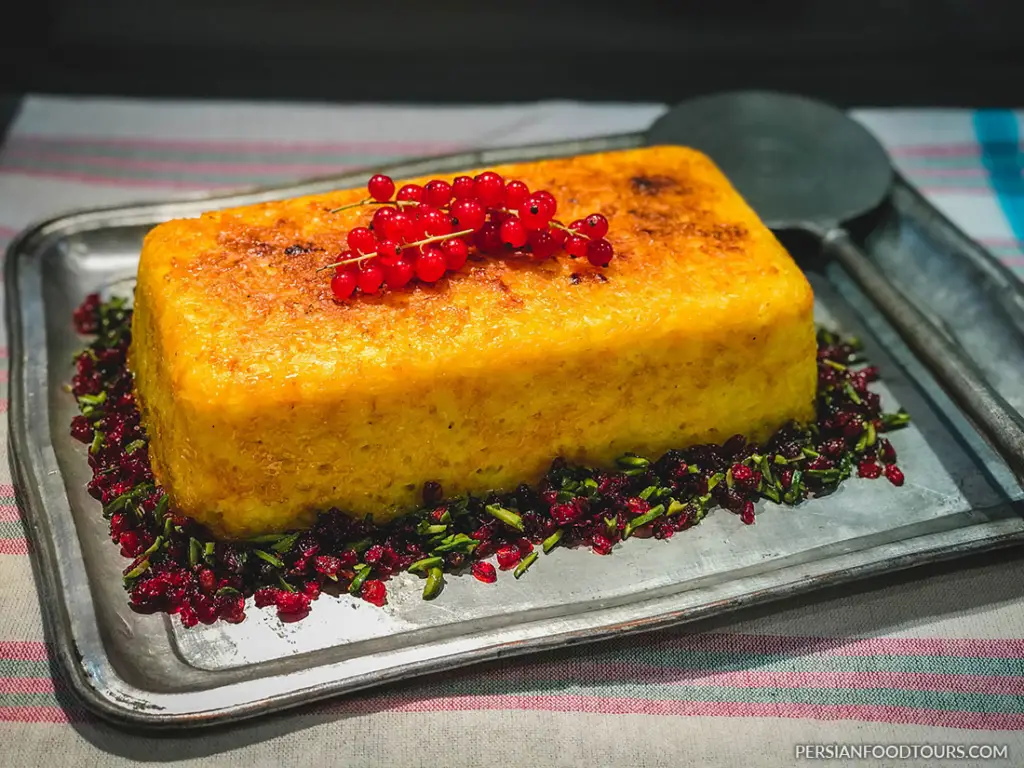
Tahchin is a popular Persian dish that features a flavorful combination of rice, yogurt, and saffron, often layered with chicken or meat. It is known for its crispy golden crust formed during cooking. Here’s a detailed recipe for Tahchin:
History and Background
Tahchin has ancient roots in Persian cuisine, reflecting the rich culinary heritage of Iran. The dish is believed to have originated in the northern regions of Iran.
National food of Iran – Tahchin Ingredients
For the Rice Layer
- 2 cups Basmati rice, washed and soaked for 2 hours
- 1 cup yogurt
- 2 large eggs
- 1/4 cup vegetable oil or melted butter
- 1/2 teaspoon ground saffron threads (soaked in 2 tablespoons hot water)
- Salt to taste
The Chicken Layer
- 2 cups cooked chicken, shredded
- 1 large onion, thinly sliced
- 1/2 teaspoon ground turmeric
- Salt and black pepper to taste
- Vegetable oil for frying
For the Crispy Top Layer (optional)
- 2 tablespoons yogurt
- 1/4 teaspoon ground saffron threads (soaked in 1 tablespoon hot water)
- 2 tablespoons melted butter
National food of Iran – Tahchin Instructions
Preparing the Rice Layer
- Cook the soaked rice in boiling salted water until it’s parboiled (half-cooked). Drain and set aside.
- In a large bowl, mix together yogurt, eggs, vegetable oil, saffron water, and salt.
- Add the parboiled rice to the yogurt mixture and mix gently until well combined.
Preparing the Chicken Layer
- In a pan, sauté sliced onions until golden brown. Add turmeric, salt, and black pepper.
- Add the shredded cooked chicken to the onions and sauté until well combined.
Assembling the Tahchin
- Preheat your oven to 350°F (175°C).
- Grease a round or rectangular ovenproof dish.
- Place a layer of the rice mixture in the dish, pressing it down firmly.
- Add the chicken mixture evenly over the rice layer.
- Cover the chicken layer with the remaining rice mixture, smoothing the top.
Crispy Top Layer (Optional)
- Mix yogurt, saffron water, and melted butter in a bowl.
- Spread this mixture over the top rice layer.
Baking
- Cover the dish tightly with aluminum foil.
- Bake in the preheated oven for 1 to 1.5 hours or until the rice is fully cooked and a golden crust forms.
- Remove from the oven and let it rest for about 10 minutes.
- To serve, invert the dish onto a serving platter, revealing the golden crust on top.
Tahchin is traditionally served with a side of fresh herbs, such as basil or mint, and yogurt.
Enjoy your Tahchin!
Iranian Cuisine – Chelo Kebab
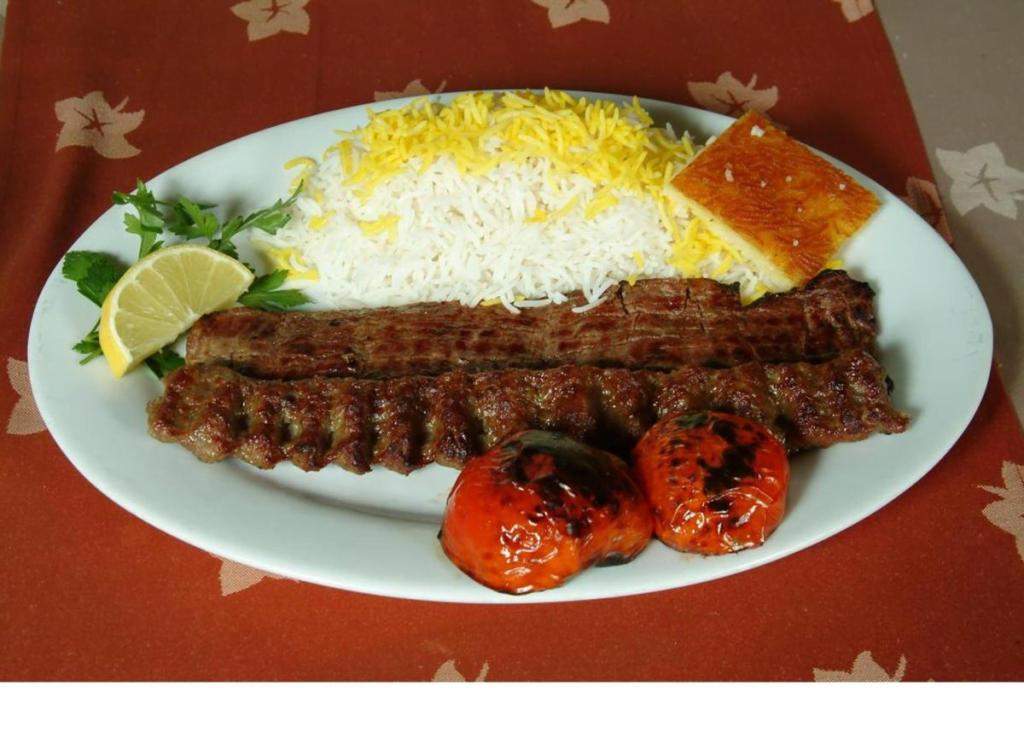
Next up, we have Chelo Kebab, a classic Iranian rice dish that pairs perfectly with grilled meat.
Some day that this is the national dish of Iran. Others say that National food of Iran is the dish described above – Tahchin
To make this dish, you will need basmati rice, saffron, and butter. The key to perfecting this rice dish is soaking the rice beforehand and creating a crispy golden crust known as tahdig.
| Ingredients: | Instructions: |
|---|---|
| – 2 cups basmati rice | 1. Rinse the rice until the water runs clear, then soak for at least 2 hours. |
| – 1 tsp saffron | 2. Drain the rice and place in a pot with 3 cups of water and 1 tbsp of salt. Bring to a boil, then reduce heat and simmer until the water has been absorbed. |
| – 1/2 cup butter | 3. In a small saucepan, melt the butter and saffron together. |
| 4. In a separate pot with a tight-fitting lid, add a layer of rice followed by a layer of saffron butter. Repeat until all the rice and butter has been used. | |
| 5. Cover the pot with a clean dishcloth, then the lid. Cook over low heat for 30 minutes to create the crispy tahdig. |
Iranian Cuisine – Shirazi Salad
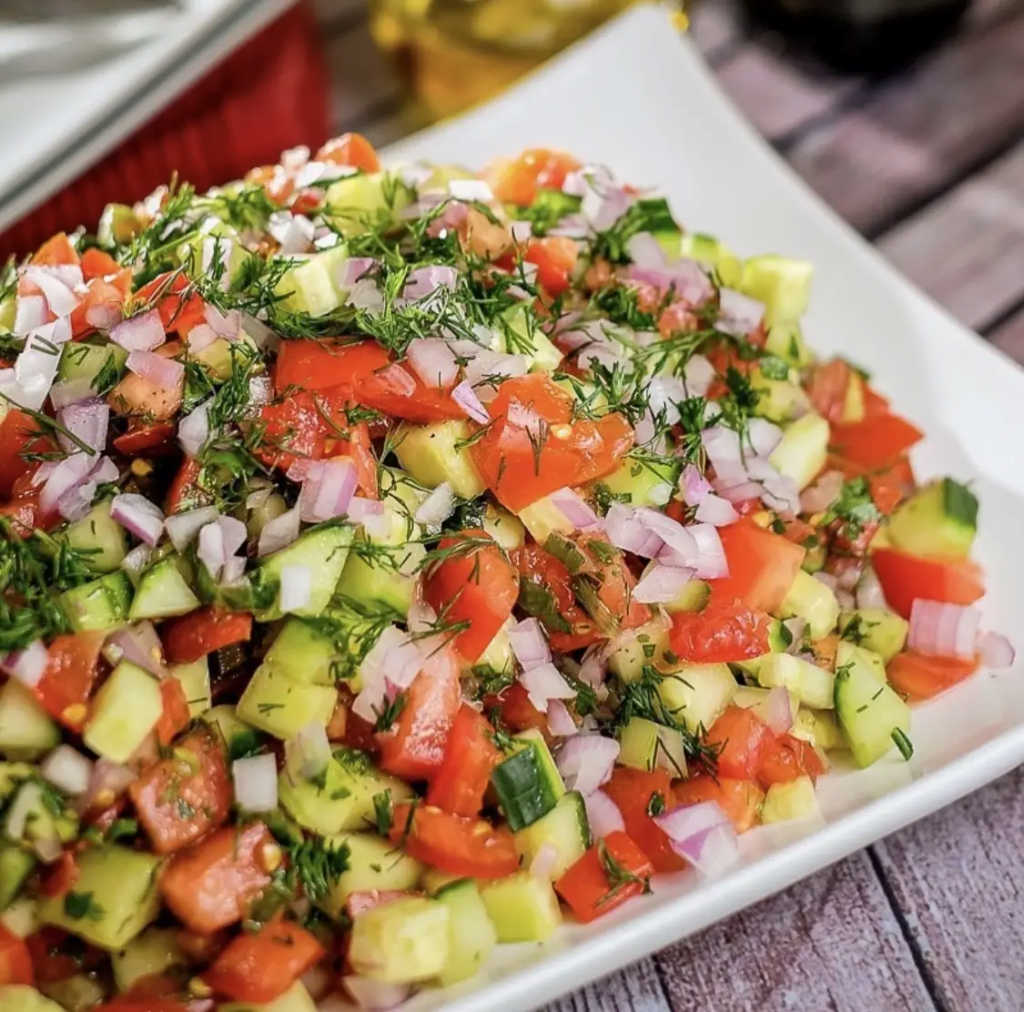
Finally, we have a refreshing salad known as Shirazi Salad. This salad is made with diced cucumber, tomato, and red onion, and is dressed with lime juice and fresh herbs.
| Ingredients: | Instructions: |
|---|---|
| – 1 large cucumber, diced | 1. In a bowl, combine the diced cucumber, tomato, and red onion. |
| – 2 medium tomatoes, diced | 2. Add a handful of fresh chopped parsley and mint to the bowl. |
| – 1 small red onion, diced | 3. Dress the salad with lime juice, olive oil, and salt to taste. |
| – Handful of fresh chopped parsley and mint |
These Iranian recipes are just a sampling of the delicious dishes waiting to be discovered in Persian cuisine. With the right ingredients and a bit of practice, you can create amazing Iranian dishes in your own kitchen. So, go ahead and give it a try!
Conclusion
Iranian cuisine is a treasure trove of flavors, colors, and aromas that beckon culinary enthusiasts to embark on a sensory journey. Rooted in a rich history and influenced by diverse landscapes, Iranian dishes showcase a harmonious blend of herbs, spices, and fresh ingredients. From the aromatic stews of Khoresht Fesenjan to the smoky elegance of Mirza Ghasemi, each dish tells a story of tradition, hospitality, and the vibrant tapestry of Iranian culture.
The essence of Iranian cuisine lies not only in the artful combination of ingredients but also in the warmth it brings to the table. Whether savoring the fragrant rice dishes, succulent kebabs, or the delightful array of sweets, one cannot escape the allure of the unique flavors that characterize this culinary tradition.
FAQ’s
What is Iranian cuisine?
Iranian cuisine refers to the traditional dishes and cooking techniques from Iran, also known as Persian cuisine. It is known for its rich flavors, diverse ingredients, and unique combination of spices. Iranian cuisine has a long history and is influenced by various cultures throughout the centuries.
What are some popular traditional Iranian dishes?
Some popular traditional Iranian dishes include Ghormeh Sabzi (a herb stew), Fesenjan (a pomegranate and walnut chicken stew), Chelo Kebab (grilled meat served with saffron-infused rice), and Tahchin (a baked saffron rice cake with chicken or lamb). These dishes showcase the diverse flavors and ingredients used in Persian cuisine.
What is the National Food of Iran?
The national food of Iran is Chelo kebab, a popular dish consisting of saffron-infused steamed rice served with grilled skewered meat, typically lamb, beef, or chicken.
This flavorful combination is often accompanied by grilled tomatoes and butter-infused grilled onions, creating a beloved traditional meal in Iran.
What are some common cooking techniques in Iranian cuisine?
Iranian cuisine utilizes various cooking techniques, including slow-cooking, sautéing, grilling, and baking. These techniques enhance the flavors and textures of the ingredients and create delicious and aromatic dishes. Each cooking technique requires specific attention to detail and is integral to the authenticity of Iranian cuisine.
Where can I find Persian ingredients for cooking Iranian recipes?
Persian ingredients are available in specialty Middle Eastern or international grocery stores. Some common Persian ingredients include saffron (a valuable spice), dried limes (used for tangy and citrusy flavors), and rosewater (used for floral and aromatic notes). Online shopping platforms also offer a wide range of Persian ingredients for convenient accessibility.
Can I recreate Iranian recipes at home?
Absolutely! With the right ingredients and knowledge of Iranian cooking techniques, you can recreate authentic Iranian recipes in your own kitchen. Experiment with the flavors, spices, and ingredients to capture the essence of Persian cuisine. Embrace the culinary journey and savor the flavors of Iran right in your home.
Is Iranian cuisine suitable for vegetarians or vegans?
Yes, Iranian cuisine offers a variety of vegetarian and vegan dishes. Many traditional Iranian dishes feature a wide range of vegetables, legumes, and herbs as the main ingredients. Some popular vegetarian options include Ash Reshteh (a Persian noodle soup), Kookoo Sabzi (an herb frittata), and Lubia Polo (green bean rice). These dishes are flavorful and satisfying for vegetarians and vegans alike.

